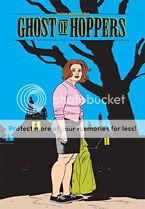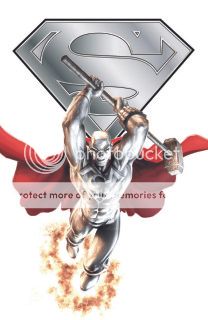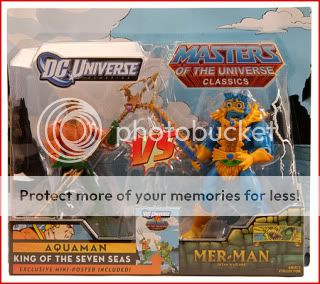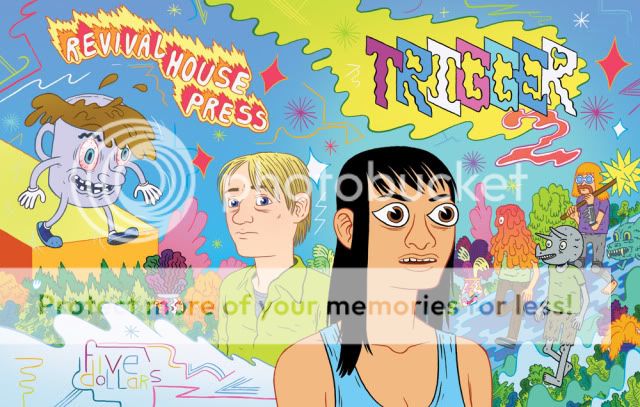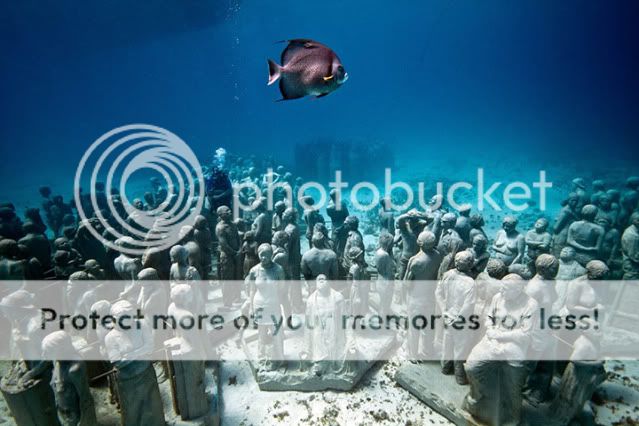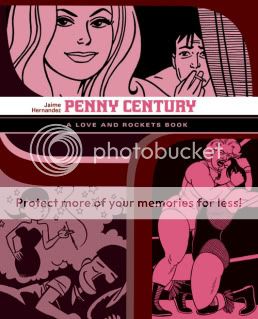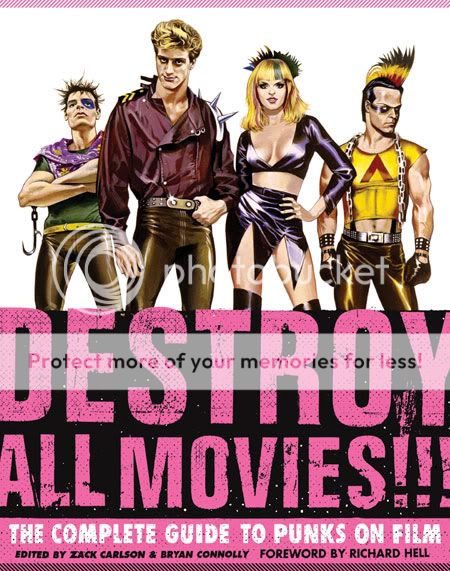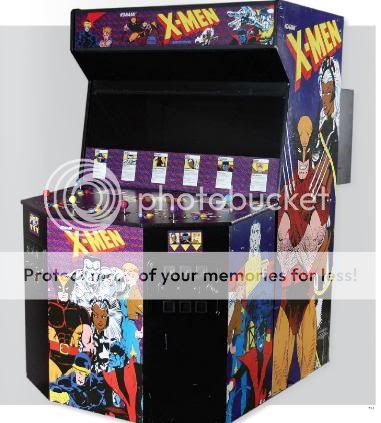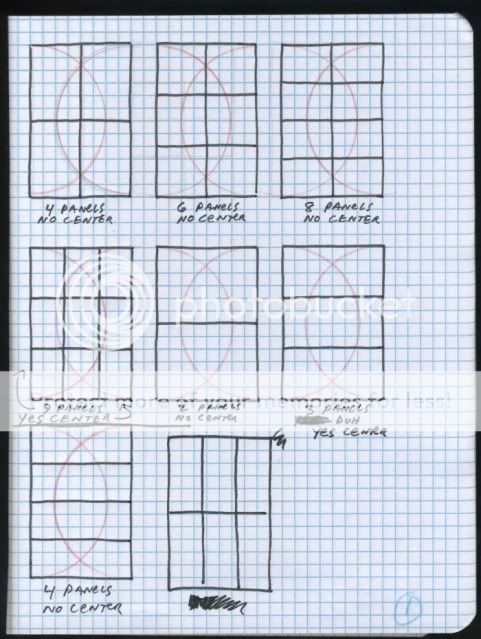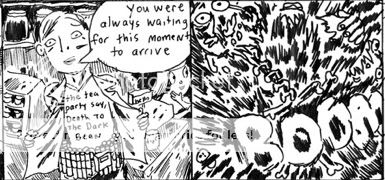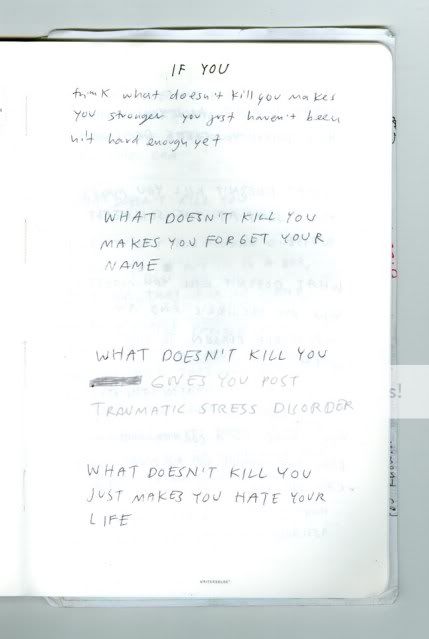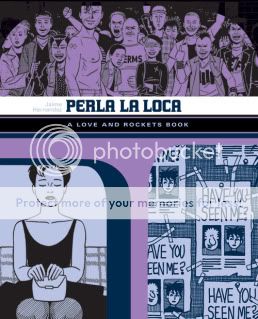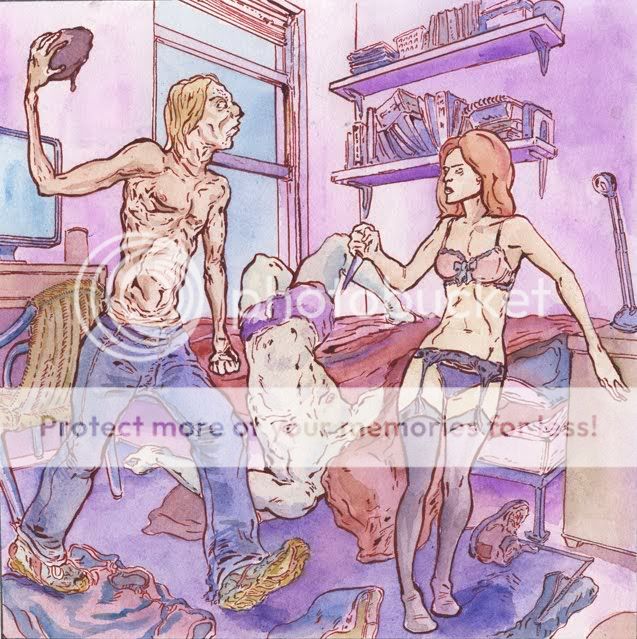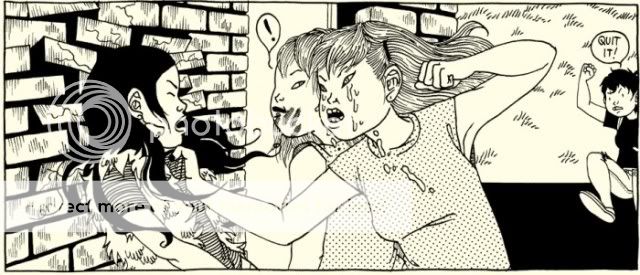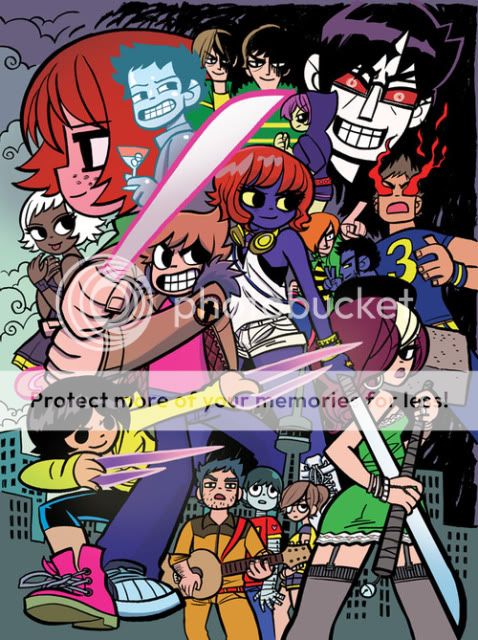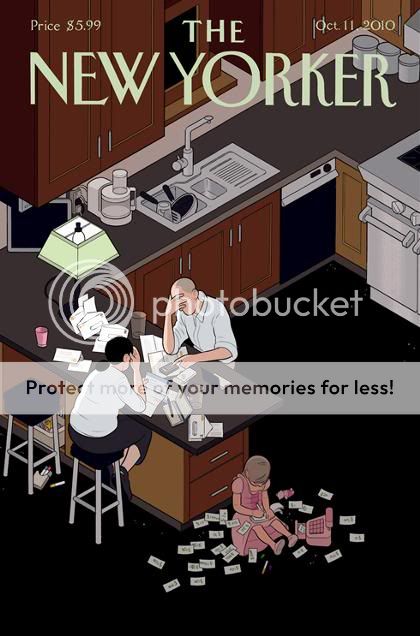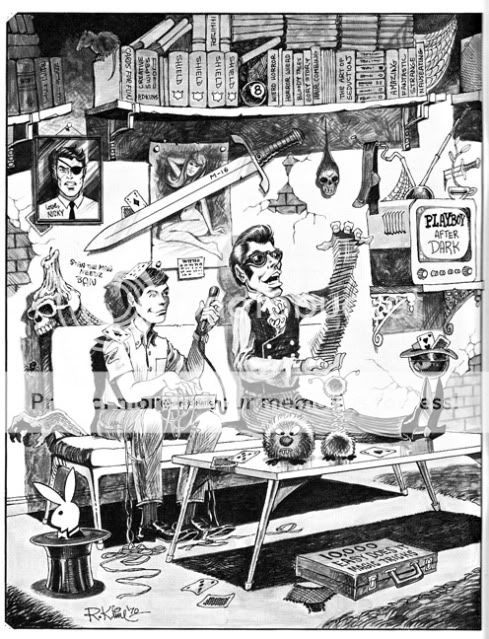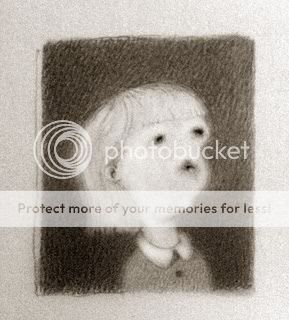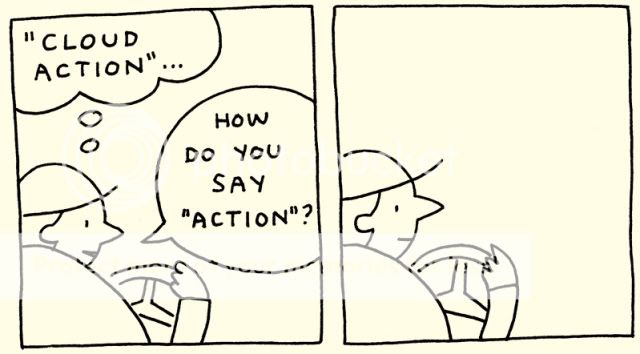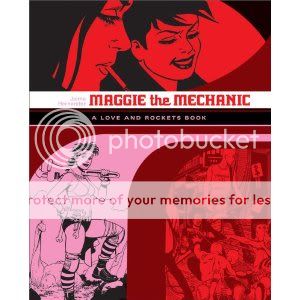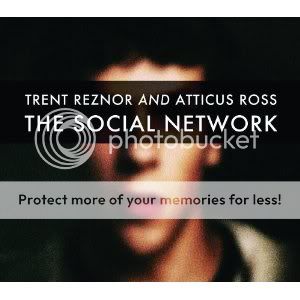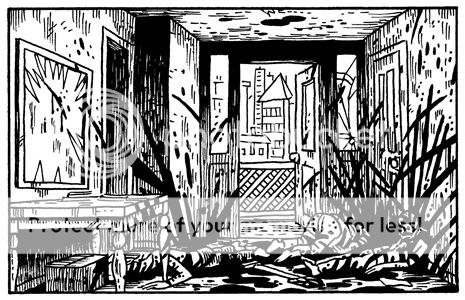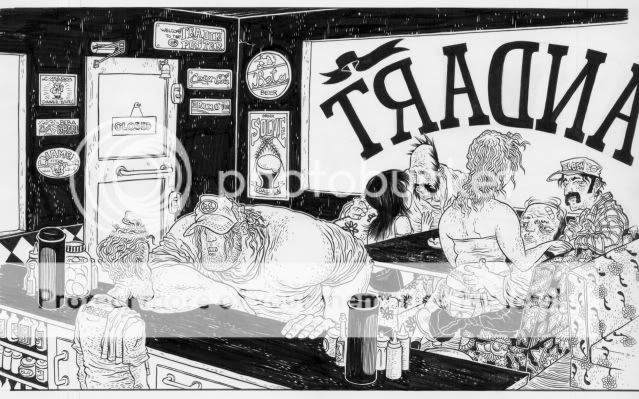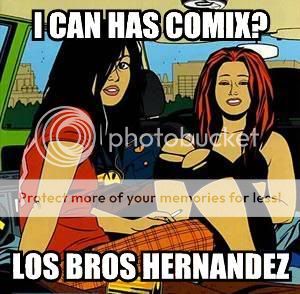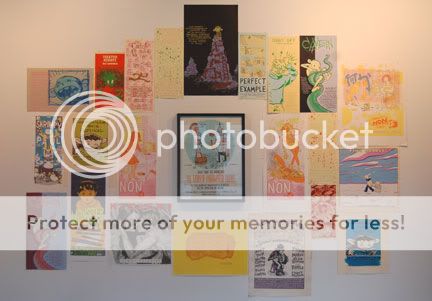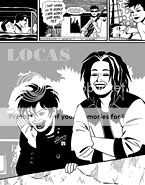Archive for October 15, 2010
LOVE AND ROCKTOBER | Comics Time: Ghost of Hoppers
October 15, 2010Ghost of Hoppers
(Love and Rockets Book 22)
Jaime Hernandez, writer/artist
Fantagraphics, 2006
120 pages, hardcover
$18.95
Jaime Hernandez has long displayed an infrequently utilized but alarming alacrity for horror. The Locas comics’ outbursts of genuine violence have been scary–I’ll never forget Hopey getting stomped on in the bathtub and staggering out, leaning naked against the door frame, or Speedy half-lit by the streetlight, a portrait of a young man at the very moment he hits rock bottom that chills me to my very soul. But in general the real terror, the real exercises in creating and sustaining horror imagery, emanate from Izzy Ruebens. Maggie and Hopey’s long-suffering, eccentric mentor has slowly withered, almost, over the years, from the semi-comical parasol-wielding goth of the strip’s early, punky days to the stoic, emaciated, frequently naked presence we’ve seen in Penny Century and now Ghost of Hoppers. Whether she’s simply mentally ill or genuinely haunted (and the two aren’t mutually exclusive possibilities, to be sure) is almost immaterial. In either case, the danger comes simply from seeing what she sees. The shadows, the stains, the shattered and inverted crucifixes, the black dog, the flies on the ceiling–these are monumental horror-images, frightening not because of some physical threat they present but the violation of reality they represent. They’re frightening by virtue of their very existence. Something is wrong with them. All of the damage they’ve caused–and based on what we know of Izzy’s guilt over her abortions and suicide attempts, the damage that caused them–has been self-inflicted.
At first I struggled with why Jaime would choose this particular storyline–Maggie Realizes She’s All Grown Up, basically–to delve deeper than ever into this aspect of the Locas world. I mean, this thing becomes a horror comic toward the end, easily the most sustained such work in the whole Locas oeuvre. What does any of it have to do with the misadventures of Maggie, the story’s protagonist? But then it clicked: She, too, is threatened here by the violation of her conception of reality. Is she the badass punker she always thought she was, or has she grown up to be a square like everyone else? Is she basically just a fun-loving straight girl with one exception that proves the rule, or might she be physically and emotionally attracted to other women after all? Is she okay with the friends-with-benefits relationship she’s had with Hopey since time immemorial, or does she want something more? Were she and Hopey really the center of the universe, or were there equally vibrant and vital relationships that continued on without them? Can she maintain her self-image as a troublemaker when she’s at a place where she really kind of hates trouble? Does Hoppers–her neighborhood, her hometown, her group of friends and fellow travelers–still exist in her mind as a screwed-up but happy place to visit, or has the passage of time rendered that all a lie? No wonder the black dog chooses now to pay her a visit. She had so much to be frightened of already. Thank goodness that life sometimes grants even hapless Locas an exorcism or two on the house.
Carnival of souls
October 14, 2010* Over at Robot 6, I explained why I didn’t go to the New York Comic Con.The long and the short of it is that regardless of whatever calculations have subsequently been made by the relevant publishers and creators–and who knows, maybe they’ve all decided that participating in one gigantic general-interest comic con per year is enough–I think a series of decisions were made by the con organizers in terms of the importance of attracting and preserving as much of an alternative-comics presence as the show’s obvious model San Diego has, and the result isn’t one I’m all that happy with. I also talk a bit about why I think NYCC gets a pass from the press that comparable shows don’t. That being said, as far as superhero/media-tie-in based comic cons go, I’m really glad New York has what appears to be a pretty top-flight and ethically administered one, though I’m told organizational problems continue to dog the show’s day-to-day operation. And there’s no reason to believe that it can’t improve in the ways I argue it needs to–Top Shelf displays at the show, as do corporate alt-imprints like Pantheon and First Second and Abrams ComicArts, and if you put that together with the relevant creators at Artists Alley and an aggressive, perhaps festival-style alt/art/lit/underground programming track, you’re halfway there.
* Related: TJ Dietsch explains why he did go to the New York Comic Con but didn’t have a good time once he got there. This mostly has to do with the organizational and crowd-control problems I mentioned above. It sounds like a ban on costume weaponry might be called for, also–I’ve heard a lot of complaints about people getting whacked in the back of the head by the gigantic swords of oblivious cosplayers.
* Also related: A dude proposed to his girlfriend at the Marvel booth during the show. Awww! My own popping of the question was surprisingly un-geeky, although I did do it at the Christmas light show at Jones Beach (I’m a Christmas nerd) and although my wife insists I waited until after the premiere of The Fellowship of the Ring just to make sure she liked it.
* I think it’s really, really, really disturbing that people can be convicted of child-porn charges for downloading drawings of Simpsons characters having sex. They’re drawings! I’m not saying it isn’t gross to me personally, but “gross to me personally” isn’t a punishable offense. What a terrible, terrible precedent to set.
* Mat Brinkman: the beer! I fully support this trend.
* Presenting a trio of provocative posts on rape, art, and outrage: Joe McCulloch on Alan Moore & Jacen Burrows’s Neonomicon #2; Tom Spurgeon on the death of Shintaro Miyawaki and his character Rapeman; and Rich Juzwiak and Sean Fennessey on Meir Zarchi’s I Spit on Your Grave, Stephen R. Monroe’s I Spit on Your Grave remake, Salem’s King Night, Southern hip-hop, and the short-lived “rape gaze” music subgenre. The congruence of these three pieces is really remarkable, right down to the involvement of Roger Ebert in the latter two. (And though this is by far the least important aspect of the discussions, Fennessey throws in a wonderful Ebert takedown, if you need the incentive.)
* Good question: Jim Henley asks if there are any pre-9/11 examples of torture by “the good guys” in pop entertainment. Before you point out, as I did, that plenty of superheroes and other fictional tough guys routinely roughed baddies up for information, Jim means “torture” in its…aesthetically understood sense, I suppose is the way to put it. That is, holding people immobile and systematically, deliberately abusing them, not just slamming them up against a wall or throwing them through a window and playing them a little chin music (even though we rightfully consider that to be torture in the real world). I can’t think of any examples–can you? The best I could do was Gandalf telling Frodo that he and Aragorn “put the fear of fire” onto Gollum to find out what he told Sauron about the Ring and Bilbo in the Lord of the Rings books–but this happened off screen and only involved a threat (and knowing Gandalf and Aragorn, most likely an empty one at that, though of course Gollum couldn’t have known that and wouldn’t have thought so), so it’s not really right. I wouldn’t count torture by charismatic villains or anti-heroes in the “hero”/protagonist role, either–like, Nicky Santoro putting Tony Dogs’s head in a vice in Casino doesn’t count.
* Killer, killer Matthew Perpetua analysis of the characteristics of “alt-rock” as a distinct musical style/subgenre. This part had me doing a double-take, it was such an eye-opener:
* Gently rolling, thick bass line. Kim Deal has so much to answer for, and even the worst of it is pretty decent. (Like, say, “Good” by Better Than Ezra.) I think Krist Novoselic’s approximation of Deal’s style was itself extremely influential. I would argue that even ahead of fuzzy guitar tone, this is the most essential and recognizable element of ’90s alt-rock, especially when contrasted with a simple, pretty guitar figure as it is on the verse of “Number One Blind.”
This reminds me of Barney Hoskyns’s really tremendous, similar breakdown of the characteristics of glam/glitter, with the “glam descend” (cascading major chords) in the “gently rolling, thick bass line” slot. I can’t find it online; I may have to rectify that.
* LOVE AND ROCKTOBER: Here’s a very good Ng Suat Tong post on Jaime Hernandez, just pulling apart a few pages and teasing meaning out of the construction of the images, which is the sort of thing you could do forever and a day with an artist of Jaime’s caliber.
* LOVE AND ROCKTOBER: In the comments downblog, Jeet Heer points out that the digest collection Perla La Loca really does read like one long graphic novel. He’s right: “Wigwam Bam,” “Chester Square,” and “Bob Richardson” are sort of the thesis-antithesis-synthesis of Hopey and Maggie’s separate, sleazy lives during that time.
* DC likes to use the dead early months of the year to do various cover gimmicks; this January’s theme, “iconic poses against huge logos,” is easily my favorite they’ve ever done. Please click the link, because they look really impressive all lined up like that. I’m running the Steel one here as part of my long-running campaign on behalf of that character. I think he’s the most undervalued hero in the DC Universe. What a badass character design. Iron Man’s m.o. with Thor’s hammer and Superman’s cape? How can you go wrong with that? Did I mention he’s an African-American under there (with the mint name John Henry Irons) in a genre that desperately needs awesome non-white heroes?
* Wait, wait, wait: Masters of the Universe Classics vs. DC Universe Classics action-figure 2-packs are a thing? For real? Do you have any idea how hard eight-year-old Sean T. Collins would have plotzed had he seen these? The answer is no. No, you do not have any idea.
Carnival of souls
October 13, 2010* Tom Spurgeon’s epic post-NYCC post is a must-read. It chronicles the biggest comics publishing announcements and analyzes the show-as-phenomenon angle as well, and it spends at least as much time talking about Brian Bolland as it does about the party scene, which displays the correct priorities.
* Kiel Phegley interviews Grant Morrison about the state of his ongoing Batman run. Nothing particularly juicy here, just the sort of stuff admirers of that run should enjoy mulling over and chewing on.
* Remember, The Great Slasher Research Project of ’10 continues! Please go and contribute. You know, it’s really bizarre, the affinity I feel for slasher movies given how few of them I’ve actually seen. I think there’s something to be said about how I love the slasher supercuts people have done on YouTube stringing together all the kills from a given franchise. Boiling a story down to a killer stalking and killing people over and over…there’s something strangely and darkly magical about that.
* I missed this NeilAlien post on the state of Doctor Strange under the reign of Brian Bendis, mostly because I hate NeilAlien’s headline-only RSS feed I guess, but it’s pretty great. There’s certainly a delicious irony to BMB, of all people, talking of the need to prevent Doc from becoming a deus ex machina.
* Spurge is right, this Mike Bertino cover is swell.
* I’m excited about the release of my chum Zach Oat’s Pop Sculpture, a how-to book for would-be makers of toys and statues. What I’ve seen of the book is hell of attractive, and Zach and his co-authors know of what they speak.
* One of the Deheza twins has left the wonderful dream-pop outfit School of Seven Bells. A) That should make for a pretty different experience than the version of the band with the dueting twin sisters; B) It’s kinda funny given that School of Seven Bells was itself formed when Benjamin Curtis left a band he was in with his sibling, the Secret Machines.
* LOVE AND ROCKTOBER Swipe file?: Readers of Gilbert Hernandez’s Palomar stories in Love and Rockets will no doubt find something…familiar in Jason deCaires Taylor’s underwater sculpture installation off the coast of Cancun. Maybe we can get Daniel Ash to play an underwater show there? (Via LondonKdS.)
LOVE AND ROCKTOBER | Comics Time: Penny Century
October 13, 2010Penny Century
Love and Rockets Library: Locas, Book Four
Jaime Hernandez, writer/artist
Fantagraphics, 2010
240 pages
$18.99
Grown-ups! More or less. This volume collects stories that follow the conclusion of Love and Rockets Volume One, the initial years-long run of the series’ comic-book format–first in spinoffs and standalones, then in L&R Volume 2–and it’s clear Jaime took the dividing line seriously. From the largely wordless wrestling action of “Whoa, Nellie!” to the less spotted-black-driven line art of the “Maggie & Hopey Color Fun” (here presented in glorious black and white), the comics in Penny Century look less dense and read that way, too. Maggie and Hopey seem to have settled down, somewhat–no longer careening from adventure to adventure or disaster to disaster, still involved in the lives and schemes of their eccentric friends but no longer completely swept up by them, still romantically (or at least sexually) entangled with one another but not to the all-or-nothing extremes of the past. The most frantic strips in the collection, “Chiller!” and “The Race,” are a late-night driving-alone mind-playing-tricks-on-Mag freakout and an out-and-out dream sequence respectively. The horns on H.R. Costigan’s noggin, heretofore the Locas strips’ only remaining visual link with their sci-fi roots, are explained away. The most outlandish thing that happens here, Izzy’s magic-realist transformation into a giant, is tied to her very adult concern about an upcoming reading from her recently published memoir, and the comic’s last remaining great free spirit, Penny Century, spends most of the book hiding from attention and is then widowed. Even the “who’s who” portrait page at the back of the book has been cut. The wild-oats-sowing crises of the sort that drove “Wigwam Bam” and “Chester Square” are over. The Locas have matured.
Ironically, perhaps, Jaime takes this opportunity to indulge himself, if not his characters. He transforms Ray D. into a sort of hard-boiled hard-luck case, whose first-person narration captions speak of falling in with femme fatale Penny and cruising for action like the least violent installment of Sin City ever. He tells his longest li’ Locas story yet in “Home School,” which reveals the origin of Izzy’s undying affection for Maggie in a fashion that’s adorable–and carefully observed–as young Maggie’s plight is revealed to be heartbreaking. He has Penny avoid the impending circus her life is about to become by also avoiding clothing. He draws page after page after glorious, please-study-this,-Avengers-artists page of women’s wrestling action, an absolute master class in conveying the physical consequences of bodies in motion and collision.
And in the collection’s gutsiest, flashiest move, he turns one of his long-running storytelling innovations into ostentation by completely eliding Maggie’s entire marriage until we learn of her divorce. Obviously, the Locas stories are full of events we only find out about after the fact–from Esther’s forced haircut to Ray and Penny’s affair–but usually the characters involved were off-screen at the time. Maggie, on the other hand, remains our main character for the bulk of this book, so finding out she married a dude during that time comes as a shock. It’s kind of gratuitous, even–it’s Jaime doing the Jaime-est thing he could possibly do with his signature character. Why? Why not? That ends up being a sufficient answer. Sure, we go along with it in the end in large part because the flashback history we discover between Maggie and Top Cat Tony is convincing, and because Locas has always been about the past’s bizarre on-again off-again romance with the present. But mostly we go along with it because it’s fun, because Jaime has earned the right to even the most spectacular stylistic flourishes–sort of how Tony’s okay with Maggie’s dalliances with Hopey, since, well, that’s Maggie. Settling down often just means owning your weirdness.
Carnival of souls
October 12, 2010* Over at Robot 6 today, I’ve got a big ol’ interview with Fantagraphics’ Eric Reynolds on the occasion of Mome‘s 20th volume and 5th anniversary. I’ve really enjoyed following Mome through the years; it seems like precisely the sort of regularly scheduled, meaty anthology people would be calling for if it didn’t already exist. Sure, there have been a lot of duds in there, but it’s also published some absolute monsters: Tim Hensley, Anders Nilsen, David B., John Hankiewicz, Josh Simmons, Kiloffer, my single favorite Jeffrey Brown comic, Al Columbia, Eleanor Davis…
* Wow, does this ever look good: Destroy All Movies!!!: The Complete Guide to Punks on Film, coming soon from Fantagraphics. Somehow this book completely evaded my radar, which is unforgivable of me. A flip through the Flickr gallery alone yielded the guy who flips Spock the bird on the bus in Star Trek IV, the surf punks from Back to the Beach, and of course The Road Warrior, which means this could not be more up my alley. I am absolutely fascinated by how punk was somehow most frequently depicted as a post-apocalyptic gang/tribe. Why the hell should that be?
* Speaking of, sort of: Powr Mastrs 3 is almost here!
* Dan DiDio and Jim Lee talk to CBR’s Kiel Phegley about DC’s price drop. I was struck by Lee’s argument that no one’s losing work because if you can do 22 pages a month instead of 20 (which is what issues will now run), that means you can do 13 books a year instead of 12. I was also struck by DiDio’s characterization of comics as a weekly experience as opposed to one best experienced a trade paperback at a time.
* Meanwhile, Chris Butcher weighs in on the price drop.
* The great World of Warcraft blogger Bruce Baugh is back at it. This time, in anticipation of the big “Cataclysm” thingamajig that I understand will literally remake the map of Warcraft’s World, he’s putting together a series of videos that take us on a guided tour of some of the WoW places and things that have most impressed and entertained him. I really like this description of WoW maker Blizzard’s worldbuilding style: “I once read a comparison to really good mainstream rock and pop acts, and that seems to me right on — it’s about combining the available material and spinning it just right, each time.”
* I’ve barely ever played this (because I always sucked at video games and lacked the patience to get better) but even I’m excited by the news that the classic Konami X-Men beat-’em-up arcade game will soon be ported to XBoxes and PlayStations. That thing really was the star attraction of any arcade it was at. (Via Chris Conroy.)
* This little Jim Fusili Wall Street Journal profile of Trent Reznor and Atticus Ross’s score for The Social Network really gets at what the music Reznor has made in this vein is about. “Or, as Mr. Reznor describes it, ‘The piece communicates tension, vulnerability, sadness and something unpleasant.'” (Via Whitney Matheson.)
* My chums at Found Item Clothing, makers of the best movie t-shirts I’ve ever seen, present their annual Halloween Costume Guide. I don’t know if I ever realized how glorious Edgar Frog’s t-shirt from The Lost Boys is. Look at this thing! It doesn’t make any sense at all…and yet I agree with every word.
Carnival of souls: Special “post-NYCC” edition
October 11, 2010* The headline says it all: ICv2’s Digital Conference In Depth. CBR’s Kiel Phegley presents an exhaustive report from Friday’s retailer/press/publisher confab at the New York Comic Con, and it’s filled with eye-opening information beyond the dire sales stats that headlined the initial reports: July and August, the traditional summer-event blockbuster months, had notably weak sales; manga publishers are losing money hand over fist by providing no legal digital venue for readers to turn to; the iPad is a big deal (surprise!); anecdotal evidence suggests digital sales may help print sales in some early and isolated cases. Provided your interest in the ICv2 conference extends past 9am the following morning and goes beyond haranguing everyone for not reporting on it properly before cobbling together a report from their reports, this is worth reading from start to finish.
* Meanwhile, John Parkin at Robot 6 has a thorough round-up of the con’s big news.
* Also at Robot 6, Kevin Melrose a dedicated round-up on Marvel’s strange semi-announcement about dropping the price of new titles next year.
* Brian Michael Bendis made several announcements the effect of which seems to add up to “Even less Powers than usual,” so I’m not really that thrilled about any of them; that said, I’ll check out an Alias reunion with Michael Gaydos, absolutely.
* According to the NYCC Del Rey/Spectra panel, George R.R. Martin is just five chapters and two months away from finishing A Dance with Dragons. I’ll believe it when I see it, but yay.
* Alan David Doane’s series of interviews with retailers about DC’s restoration of the $2.99 price point continues with Earthworld’s J.C. Glindmyer. Meanwhile, writing at his own site, Brian Hibbs expresses what it seems like a lot of the retailers Alan has spoken with believe: Scrapping the $3.99 price point is a good idea, but its institution “broke the habit” of collecting those series for a lot of readers in such a way that they probably won’t return.
* Tim O’Shea interviews Renee French about H Day, her new PictureBox graphic novel. Turns out it’s inspired by the imagery that came to mind when she had migraines. In other words, this oughta be good.
* Wow, this is a pretty terrific line-up for the new Studygroup12 anthology: Trevor Alixopulos, T. Edward Bak, Chris Cilla, Max Clotfelter, Farel Dalrymple, Eleanor Davis, Vanessa Davis, Michael DeForge, Theo Ellsworth, Jason Fisher, Nick Gazin, Richard Han, Aidan Koch, Amy Kuttab, Blaise Larmee, Corey Lewis, Kiyoshi Nakazawa, Tom Neely, Jennifer Parks, Karn Piana, Jim Rugg, Tim Root, Zack Soto, Ian Sundahl, Jon Vermilyea, Angie Wang, Steve Weissman, and Dan Zettwoch.
* Frank Santoro takes us to layout school. The “lose the center” concept hit me like a ton of bricks.
* I love Brian Chippendale’s Puke Force.
* Danny Boyle wants to direct a third 28 Days Later movie. I want him to! (Even though Fresnadillo’s 28 Weeks Later was the better film.)
* Real Life Horror #1: The Republican Party’s repeated intimations of militarization have disturbing implications–wait, what? Oh, Jesus.
* Real Life Horror #2: As Glenn Greenwald runs down a number of jaw-dropping factual reasons why this isn’t in fact the case, I think it’s impossible to overstate the damage that the concept “America is the greatest country in the world/in history” has done to America. If we’re the greatest country on Earth, how bad could our problems possibly be, right? We’re a nation of Lord Summerisles, proclaiming “They will NOT fail!”
* Anders Nilsen presents “What Doesn’t Kill You…”: variations on a theme.
LOVE AND ROCKTOBER | Comics Time: Perla La Loca
October 11, 2010Perla La Loca
(Love and Rockets Library: Locas, Book Three)
Jaime Hernandez, writer/artist
Fantagraphics, 2007
288 pages
$16.95
Things take a turn for the unpleasant in this volume. I don’t mean sad or heartwrenching–they’ve already done that; I mean unpleasant. Taking a look that old negative review of Locas I wrote, I’m pretty sure this is where Jaime lost me completely the first time around. Ray can’t get it together enough to hang on to Danita, and she skips town. Doyle can’t get it together enough to hang onto himself, and he skips town. Penny’s pretty much settled into the unfulfilling life of being Mrs. H.R. Costigan, theoretically banging out kids with her manservants as a way of passing the time. Maggie brings disaster everywhere she goes (though she means well, at least). And Hopey! With the image of her smoking on the toilet while pregnant still fresh in our minds from the last volume, she she falls in with a bunch of people just as glib and nasty as she is–only as it turns out they’re even worse, and several people are beaten nearly to death for her to learn that lesson. Love and sex were never quite “carefree” in the Locas stories–people pined and got hurt at least as often as they had a great time or did really romantic and loving things–but in this volume the sex gets downright seedy, transactional at best and joylessly fetishistic at worst. It’s a book about creeps.
Fortunately I’m now able to accept that. I don’t know what the hell came over me when I wrote that old review, to be honest. In what world does making art about creeps necessarily constitute and endorsement of being a creep? Upon this re-read it’s quite clear that Jaime is in no way rah-rah’ing Hopey’s behavior, which he consistently depicts as show-offy, designed for audience consumption. I mean, she elbows a crowd of prostitutes out of the way to go down on someone, and out-hipsters everyone by declaring an aging TV star’s pedo-fetish lifestyle: “I think it’s super-cool.” No one must ever accuse Hopey Glass of being in any way square! As we see from flashbacks to her as a squirmy little girl refusing to sit still for a photographer, and as a teenage asshole subjecting her loyal friend Daffy to a humiliating encounter with an S&M whackjob, she thrives on other people’s disapproval. She lives to be a magnificent bastard. Only this time around, the bastardry comes back to bite her.
Maggie is a much nicer person and therefore her story is a lot nicer, but she’s now getting less out of her basket-case love life than ever. Far away from anyone with whom she ever had a good thing going–Hopey, Ray, Casey, even Speedy or Race–she falls into a pattern of breaking the hearts of the people who are interested in her and screwing up the lives of the friends who aren’t. Her chaos has become contagious. And her now-rare moments of sexual intimacy use cash as a buffer. “The real secret is that I really didn’t feel bad about doing it,” she confides, “Like it was no big deal.” What a relief that must be to her, since “everything is a BIG DEAL” is basically her life story!
So what conclusions are we to draw from all this? It’s taken me a while, but I’ve come to the conclusion that drawing a conclusion is the wrong thing to do. There’s not some message being sent here about, I dunno, punk or fluid sexuality or sex work, which are sort of the common threads of the two big stories here–the Hopey-centric “Wigwam Bam” and the Maggie-centric “Chester Square”-to-“Bob Richardson” suite. The message, I think, is simply to be found in the fact that there are two big, separate Maggie and Hopey stories here. They’re not symbols, they’re people. Here you have two people who were once so inseparable and similar that their friends and enemies called them The Incest Twins, and now they’re finally, really living apart. When two people have formed their identities in such an inextricable way–in Maggie’s case it’s so profound that it’s the exception that proves the rule of her sexual orientation itself–what happens when you extricate them? Well, they make some really shitty life choices, they have a hard time figuring out who they are, they hurt some friends, they get some other friends hurt, they make still other friends wonder if they were really such great friends to begin with, they hurt themselves, and they start–barely–to move on. All in the hands of the kind of artist who can draw characters to have family resemblances or to look enough alike that other characters can’t tell them apart, but we the readers can even while seeing those resemblances. Story made possible by sheer chops. Damn.
Carnival of souls
October 8, 2010* Graphic novel sales down 20%, manga down 20%, comics up 1%, industry down 12% over the past year, according to Milton Griepp of ICv2. Ugh.
* Bob Wayne has been promoted to Senior VP of Sales at DC; his department will stay in New York.
* Dark Horse will charge $1.49 per downloadable comic. We’re getting there…
* As Tom Spurgeon points out, the vague Marvel price-decrease announcement yesterday appears to amount to doing away with the $3.99 price point for new series, not eliminating it for all ongoings the way DC will be doing. Part of me feels like if you’re not reducing the price for the top-of-the-industry Avengers titles, why bother. But then, that’s approaching this issue from a perspective Marvel might not share. If you believe that charging four bucks per issue for the best sellers is choking off the midlist and you’re really interested in freeing up cash for that midlist, that might lead you to do one thing; if you believe midlist prices are what’s choking off the midlist, that might lead you to do something else; if you don’t mind the midlist being choked provided it’s not just your own company’s line being affected, that might lead you to do a different something else. I think a big question remains whether Marvel and DC will scale back production of midlist-type series over the next year in addition to whatever pricing moves they make on both the print and digital end.
* For what it’s worth, Alan David Doane talks to retailers Robert Scott, John Belskis, and Peter Birkmoe about DC’s price reduction; all three of them are skeptical that it’ll make any difference at their stores.
* Kiel Phegley interviews Jean Schulz on Peanuts‘ 60th anniversary. It’s interesting to hear how the strip looked and looks from the perspective of the person closest to the person who made it.
* Chris Mautner reviews Acme Novelty Library #20, the most daunting thing a comics critic can do in 2010.
* Christ, is Frank Santoro’s Strange Tales II strip gonna be gorgeous or what? Previews of Rafael Grampa, Jillian Tamaki, Nick Bertozzi, Dash Shaw and more at that link, by the way.
* Always happy to see new Isaac Moylan art.
* Thundarr the Barbarian is now available on DVD. I wonder how it holds up.\\
* It’s not too late to get in on The Great Slasher Research Project! What makes a slasher film a slasher film? Go let ’em know!
LOVE AND ROCKTOBER | Comics Time: The Girl from H.O.P.P.E.R.S.
October 8, 2010The Girl from H.O.P.P.E.R.S.
(Love and Rockets Library: Locas, Book Two)
Jaime Hernandez, writer/artist
Fantagraphics, 2007
272 pages
$14.95
Do you ever stop to think that David Lynch’s work doesn’t make sense? No, not in that way–I don’t mean in terms of story logic, I mean in terms of his aesthetic/generic approach. In that case, your answer is probably “No, I haven’t.” But seriously: Pre-Beatles rock and roll nostalgia, soap-operatic melodrama, supernatural beings, naked ladies, small towns, Los Angeles, non-linear narratives, hideous violence, Angelo Badalamenti…there’s really no reason why all of that should get lumped together, or why all of it should work together, but somehow it does and so you almost never pay attention to what a hodgepodge it is. Something about what Lynch does, the confidence with which he does it, makes it feel seamless, like “of course” rather than “what the?”.
Looking at the cover for The Girl from H.O.P.P.E.R.S., I realized the same is true of Jaime Hernandez’s comics. There isn’t any particular reason for a sprawling slice-of-life saga to concern itself with punk rock, Mexican-American teenagers and twentysomethings, a pair of on-again off-again girlfriends/best friends, barrio life, and professional women wrestlers, with a soupcon of comic-book sci-fi thrown in now and then–no reason beyond that’s what Jaime was interested in making comics about. But you read a story about Hopey ditching Maggie to tour with the shitty punk band she’s in with her ex-girlfriend, and Maggie getting over that and the murder of the dude she’d been into for years/her Goth friend’s cholo kid brother by becoming the sidekick for her aunt/the women’s heavyweight champion, without batting an eyelash. That’s what a Jaime comic is, the same as a David Lynch movie is doppelgangers, broad comedy, hot sex scenes, early ’60s pop classics, a cameo by some impossibly cool rock star, and someone getting their brains blown out. He created his own kind of story.
So that’s thing #1 that struck me about this collection, wherein the sci-fi stuff is largely dropped once you get past the opening section (and is outright rejected in a cheeky self-parodying strip that ends with present-day Maggie tossing aside a “Maggie the Mechanic” comic book with a “yeah, right”) and wherein the Locas material goes from being a really good comic to a really great comic. Thing #2 is that Tom Spurgeon is right to list “memory” as one of Jaime’s hallmarks, above and beyond “spotting blacks” or “portraying rock and roll in a way that actually captures what’s awesome about it” or “drawing cute girls in bathing suits.” I think it’s the introduction of extensive flashbacks that makes this material so strong, so fascinating, and so epic in scope. For starters, it’s fantastic in a fannish way to learn the “origin stories” of Maggie & Hopey (“The Secrets of Life and Death Vol. 5,” “The Return of Ray D.”), Hopey & Terry (“Tear It Up, Terry Downe”), and Izzy (“Flies on the Ceiling”). A student of superhero comics like Jaime was obviously gonna cotton to the appeal of that sort of thing.
And of course, flashbacks serve to flesh out Jaime’s ever-expanding cast of characters. In that interview I ran the other day, Jaime mentions how he’d pick out characters he’d drawn in the background and use them whenever one of his main characters needed a new boyfriend, say–fleshing out the Locas world with stuff that’s already present. Flashbacks do the same on a narrative level: You don’t need some big character-revealing adventure with new character Doyle, say, with all the implications that might have for where you want to push the present-day story of everyone he interacts with, when instead you can rewind a few years to “Spring 1982” to see what he was like then. The contrast that arises between the genial slacker we met earlier in the volume, with his tousled hair, stubbly chin, drooping cigarette and shit-eating grin, and the scowling ex-con and ex-addict so scared of his potential to do wrong that he literally flees town we see in this flashback story says more than enough about the potential for characters in the Locas-verse to grow and change.
But from a formal perspective, this is where Jaime really starts playing with gaps on comics’ atomic level, that of panel to panel transitions. There’s this one great, totally unnecessary bit where Maggie’s fearsome aunt Vicki’s wrestler boyfriend comes to Maggie to divulge that Vicki really does care about how Maggie feels about her, but rather than stick that in a word balloon or three, Jaime jumps from a panel on the left in which the guy says “Wait, kid. Listen to me a second…” to a panel on the right where Maggie, already storming away, says “She said that, huh? So what am I supposed to do, feel sorry for her when she breaks my arm?” You’re not jumping from place to place or era to era here, you’re not doing anything that might occasion a jump cut in a more traditionally executed comic–you’re just skipping a non-essential part of a conversation, without missing a beat. Time is porous in Jaime’s hands, prone to dropping out from under you or skipping back and forth within a single page, let alone from story to story. The rise to prominence of flashback stories reflects that on an “as above, so below” level.
Most importantly, though, I think, is that this collection is where death becomes a presence and a factor in the characters’ lives. Not the impersonal, absurdist, satirical deaths caused by the depredations of Maggie the Mechanics mad sci-fi robber barons (and wasn’t it funny that the science fiction adventures Maggie had were the opposite of escapist–she was constantly hoping to escape from them?), but the death of family members and friends and babies, murder and the threat of murder, criminality and insanity. It’s the volume where you learn how Speedy, really without even thinking about it, has hurt too many people over the years too badly for them to stay close to him when he needs them the most; how Izzy is so haunted by guilt that, regardless of how literally you want to take what we’re shown here, it’s become a relentless, inescapable presence in her life, quite literally destroying her personality. Awareness of death, of our mortality, is part of what makes us distinctively human; I think the ability to remember is just as integral to us. Certainly that’s the argument Jaime makes when he ends “The Death of Speedy Ortiz” with a one-page flashback to a wedding reception of no particular importance. Memory is how we fill in the gaps death leaves behind.
Carnival of souls
October 7, 2010* Another big big day on Robot 6…
* Both DC and Marvel are reducing prices on their comics. DC is scrapping the $3.99 price point for ongoing series in favor of $2.99, and dropping page counts as well to a 20-story-page standard. Marvel hasn’t made their plans clear but they’re working on it, I guess. In both cases the changes will take effect in January. I’m glad to see both publishers basically say “We tried something, it didn’t work, so now we’re gonna do something else”–I think that $3.99 price point on all the most popular titles was absolutely murdering the midlist, and not doing wonders for the most popular titles either. Of course, reducing content means reducing creator income.
* Fantagraphics is having a 20% off/free shipping on everything sale, as long as you can wait till October 20th for your order to be shipped. Worth the wait.
* New Hellboy and B.P.R.D. miniseries are launching in January.
* Hellen Jo has joined Jordan Crane’s webcomics portal What Things Do by posting Jin & Jam #1 in its entirety. This site, man, I’m tellin’ you.
* Scott Pilgrim vs. the X-Men! Well, he already fought Captain America and Superman, so why not.
* Today’s must-read: Curt Purcell on Al Columbia’s Pim & Francie: Golden Bear Days, which got my vote for Best Comic of 2009 if you recall. Money quote: “Honestly, as I closed the book upon finishing it, I almost regretted having exposed myself to it, and I’ve since experienced some intrusive thoughts of unwanted imagery from its pages.” Yes.
* Aw man, I screwed up the link to CRwM’s very awesome Great Slasher Research Project. That’s the right link–please go visit and put your two cents in. My take so far is that people are painting with too fine a brush, although now I also see flaws in my own suggested definition.
* Without linking to anything in particular, I just wanna point out that Alan David Doane and Christopher Allen have relaunched Trouble with Comics and it’s been rock-solid so far: Linkblogging, reviews, interviews, commentary, minimal invective. ADD relaunches his blog almost as frequently as Marvel relaunches its Hercules comics, but I hope this version sticks. It looks nice, too.
* Stalwart HBO-drama director Tim Van Patten, late of Boardwalk Empire and best known for The Sopranos, will be working on Game of Thrones. That’s very good news.
* Lately my pal Rob Bricken of Topless Robot has been on a “my sentiments exactly” tip with regards to nerd news of note. Here he is on Zack Snyder directing Superman:
At least — and I mean at least — with Snyder directing, I can take solace that in this movie Superman will probably fucking punch somebody.
And here he is on the triumph of James Cameron and Avatar:
Look, I know that pretty much none of us give a shit about Avatar any more, if we ever did. But every time this movie gets brought up, it makes me more and more upset. Seriously. It’s the #1 movie in the world, and the #1 Blu-ray. And yet it’s not very good. Oh, I still think the 3-D was impressive and worth seeing in theaters, but buying it on home video? Watching it again without 3-D? Or hell, watching it again in 3-D in the theaters? I just can’t fathom who would want to do that or why. I feel like I’ve woken up in a parallel universe where everything’s the same except an exceedingly mediocre, albeit expensive, film is the most popular movie in the world. I do not understand.
Nerd bafflement is vastly preferable to nerd rage, don’t you think?
* Real Life Horror #1: I’m not sure which side–the ones who concocted the stupid thing or the people who got really upset that other people would sink so low as to concoct it–Nate Silver was picking on when he tweeted about how the “ground zero mosque” has disappeared from the news and thus it might be time to “start making fun of those who called it a ‘game-changing issue,'” but my first thought was that “it sure changed the game for Muslim-Americans,” and sure enough.
* Real Life Horror #2: Here’s a solid post by Daniel Larison on the egregiousness of the Obama Administration’s extra-legal American-citizen assassination program. Or murder, if you prefer. (Via Glenn Greenwald.)
* Now here’s a great idea for a comic: A period piece about three junior high kids roaming around town one night trying to rent a copy of Dead Alive before the video store closes. Make it high school instead of junior high and I have been that kid. Cartoonist Brent Schoonover, creator of The Midnight March, if you’re listening, please get in touch so I can read this thing!
Music Time: Incubus – “Stellar”
October 7, 2010Incubus
“Stellar”
from Make Yourself
Sony, October 26, 1999
Here’s an interesting case of coulda woulda shoulda. I used to hear this song all the time on modern-rock radio ten years ago, when I had a job driving around Manhattan as a production assistant on the show David Milch did before Deadwood–one of the very few songs of that era that could get me to leave modern-rock radio on for longer than three seconds at a time. Hearing it on the radio again the other day made me realize both why that was and why I still didn’t run out and buy an Incubus record.
You’ve got a perfectly lovely, bubbly little guitar part that conveys the song’s spacey central metaphor by sorta curling up and outward over and over again, like astronauts twirling around in zero gravity. Beneath that there’s a pleasant two-note bass pulse to give it a little forward motion. And there are some striking images in the lyrics, too: The opening “meet me in outer space” is obviously the descendent of a very long line of moonstruck rock lyrics, but lead singer/shirtless handsome man Brandon Boyd delivers it quietly, not with the come-fly-with-me brio you might expect. The following line, “We could spend the night, watch the Earth come up,” is a clever little reversal of the usual romantic evening. And I really do love the way he suddenly kicks the song up like twelve notches before the chorus: “We could start a-GAAAAAAAAAAAAAAAAAAAIN!!!!!” Whoa, where’d that come from? For the second verse that bit’s even better because it accompanies a really direct and really sensual set of lyrics in which Boyd explains to his beloved that taking her to outer space “might be the only way that I can show you how it feels to be inside you.” That might be a little too direct for some listeners, but I’ve always found that sort of sentiment to be very candid and very sexy (“Not Enough Time” by INXS and “Closer” by Nine Inch Nails being two other cases in point).
It’s not until I heard the first chorus itself this time around that I realized “Oh, so that’s what’s going wrong here”–it’s the drums. They pound away way too hot in the mix…and on one and three, like an audience of white parents trying to clap along to the gospel song their children are singing at a middle-school chorus concert! It’s crazy–completely kills any kind of groove or flow, makes that big chorus sound like inert shouting rather than passion. And what’s more, it continues at just slightly a lower level throughout the second verse, making it a slog rather than a weightless orbit. For a band that I think is supposed to be at least slightly groove-oriented, it’s a pretty shockingly obvious misstep, and it transforms a potentially really lovely modern power ballad into something with some nice moments that you don’t really ever wanna listen to on purpose. Coulda woulda shoulda.
Carnival of souls
October 6, 2010* Your must-read of the day: Every once in a while an article or interview or essay comes along that’s a sort of “The Way We Live (If We Are Awful) Now” kind of deal. This New York Times piece by David Carr on the misogynistic, mismanaged nightmare the Tribune Company has become under the reign of Sam Zell and Randy Michaels is such an article. Rich white sexist assholes enriching themselves at the expense of everyone else in an almost emblematic fashion.
* Now here’s a way to fulfill your civic duty this October: Over at And Now the Screaming Starts, CRwM has launched The Great Slasher Research Project of ’10. [UPDATE: Link fixed.] He’s looking for potential definitions of the slasher subgenre–the necessary and sufficient conditions that make a slasher movie a slasher movie. You start with “I think the elements common to all slasher movies are” and then submit a numbered list. I took a stab at it (rimshot!)
I think the elements common to all slasher movies are:
1. A killer
2. Killing a succession of people
3. With a bladed weapon
4. After stalking/chasing most of them
This was fun; it reminds me a lot of back when I tried to come up with a definition for torture porn. Please go over to CRwM’s and give it a shot.
* io9’s Geek’s Guide to the Galaxy podcast interviews George R.R. Martin. Cue it up to 52:54 for Song of Ice and Fire/Game of Thrones talk, and then to 1:03:03 for further discussion of the books by the hosts (who include anthologist John Joseph Adams, who put together a post-apocalyptic collection called Wastelands that was actually too bleak for me to finish. Me!). Everyone’s story about coming across these books is the same story: Someone enthusiastically recommends it, the person’s like “yeah, okay, fine,” and within an hour’s reading they’re enthusiastically recommending it to someone else.
* Robot 6’s Chris Arrant interviews my chum Ryan Penagos, aka Twitter deity Agent M.
* Chris Ware New Yorker cover! Exclamation point!
* Behold: Steranko and his youthful ward Gary Groth.
* Renee French is a national treasure.
* John Porcellino comics online. What a country!
* I thought Lucio Fulci’s Zombi 2 stunk on ice aside from that shot of that worm-eaten zombie that everyone knows, but in the interest of equal time, here’s Not Coming to a Theater Near You’s David Carter making the case for the film as an exemplar of an Italian-horror version of surrealism.
LOVE AND ROCKTOBER | Comics Time: Maggie the Mechanic
October 6, 2010Maggie the Mechanic
(Love and Rockets Libary: Locas, Book One)
Jaime Hernandez, writer/artist
Fantagraphics, 2007
272 pages
$14.95
If it weren’t for Jacob Covey and Bryan Lee O’Malley, I don’t think you’d be reading this post. Aside from Jaime Hernandez himself, they’re the two men most responsible for persuading me to pick up the digest editions of Love and Rockets that Fantagraphics began releasing a few years back, and for how hard those digests clicked with me when I did. Covey’s attractive design of the digests made the most of the power of Jaime’s art, individual panels of which work as stand-alone images as strongly as those of any cartoonist ever to put pen to paper. (I recognized that even as a Jaime skeptic.) Combine that with bright colors and the digest format itself–chunky enough to feel substantial, light enough to fit in a backpack and be read comfortably on the train or the beach, tailor-made to be lined up on a bookshelf–and you’ve got a series of books that are compulsively collectable and readable. O’Malley’s Scott Pilgrim series served a prophetic role in this regard: A format that’s similar (though not identical) and similarly delectable; crisp, stylish black-and-white art incorporating a variety of traditions and influences into the basic alternative-comics tradition; a fast and loose approach to genre fiction that uses it as a spice rather than the main ingredient; compelling portraits of an incestuous social circle of music-interested, kind of feckless young people with disastrous love lives…reading Scott Pilgrim primed me for revisiting Jaime’s “Locas” material, ready to accept it for what it is (“Locas”!) rather than what it isn’t (“Palomar”). No, I could never go back and recreate the experiences of the long-time die-hards who grew up with Maggie and Hopey in every individual issue; but barring that, I’d found the ideal combination of content and format. Putting it all in fun little digests rather than a big portentous hardcover somehow made it all click.
And so, instead of being put off by Maggie’s borderline-bipolar hysterics, Hopey’s surliness and occasional cruelty, and Penny’s bombshell ridiculousness…well, that’s who they are, isn’t it? I feel like it’s somehow an insult to the whole critical project if I say “I used to find them all pretty annoying, but then I learned to accept it and move on”–like, c’mon, was it really that simple? And the answer is yes! Instead of bashing my head against the fact that they weren’t more together, or that they weren’t falling apart in the way my personally preferred alternative-comics protagonists tend to fall apart, I suddenly found myself digging it. For example, it’s funny and endearing watching Maggie fall all over herself around the alpha males she’s attracted to, and to contrast this with the alpha females with whom she surrounds herself as friends. Izzy Ruebens, Penny Century, and Hopey Glass are all a bit whacked-out in their own ways, but the personas they’ve constructed for themselves as a way of dealing with their problems are rock-solid, even overwhelming to newcomers. Maggie Chascarillo, by contrast, is an open book–even her attempts to cloak her true feelings send an equally true message in block letters five feet tall. Her inability to repress herself is her charm, and it’s reflected by the physical business Jaime is constantly involving her in–crashing hoverbikes, breaking machinery, ripping her pants, getting tossed around by wrestlers and thugs and explosions. She’s sort of an explosion herself!
(On a related note, I almost threw Terry Downe on my list of the alpha-Locas, but I can’t get around that one heartbreaking panel in this collection where her glacial hardass facade crumbles and she begs Hopey to tell her what Maggie has that she doesn’t. Hopey’s hold over Terry is that she brings out the Maggie in her.)
Making his protagonist a basketcase (albeit a sexy one–let’s be honest, that’s a big part of the appeal of this material too) is just one part of what impresses me so much any time I revisit this material: I’m struck by just how confident it is in itself. What I really mean by that, of course, is LOOK AT THIS FUCKING COMIC. Can you imagine what the reaction would be if a cartoonist today came out with a debut with the chops Jaime’s displaying in the very first issue? Keep in mind I’m not just talking about the crosshatchy prosolar-mechanic sci-fi stuff: The second story is “How to Kill a…,” a wordless, increasingly abstracted portrait of Izzy as a young writer, hinting not only at the formal mastery Jaime would later display (it’s all jumpcuts and comics-as-design), but at the psychological (and supernatural!) depths Izzy’s gothy exterior would be revealed to contain years later.
And on a narrative level, Jaime spends no time at all explaining his world, why it bounces back and forth between a realistic portrait of young poor Latina punks and a light-hearted science-fiction satire of Reagan-era Latin-American political upheavals. Like magic realism gone Marvel Comics, it just throws you right into the deep end and expects you to swim. This is true even if you’re just talking about the realistic stuff, the person-to-person relationships, and it’s established right in the fourth panel, where Maggie complains about having had too much to drink last night: These comics predicate themselves on things that already happened. Nearly any time a new character is introduced, they’re after money someone owes them, or getting teased for the crush they’ve been nurturing on another character for years. It’s an in medias res world.
Okay, so a lot of it will be filled in with flashbacks eventually. We get a glimpse of this in “A Date with Hopey,” the story that concludes this volume and is its strongest single strip. Our hapless hero Henry’s one and only appearance relates how his sporadic, intense friendship with Hopey evolved into unrequited love, ended in rejection, and now exists as a bittersweet memory; the laserlike precision with which the story pinpoints powerful emotions nearly everyone has experienced serves as a model for the future of the Locas stories. (And, contra what I used to think, it’s proof positive that Jaime is fully aware of the damage Hopey can carelessly inflict, even as its her carelessness itself that makes her so irresistible.) But the way you’re just dropped into Maggie & Hopey, Already In Progress, is pretty much why I continue to recommend this volume, rather than its relatively sci-fi-free successors, as the place to start if you’re interested in Jaime’s work. I understand why that doesn’t work for everyone–and it’s true, the earliest comics are relatively talky and old-fashioned-looking as befits their influences. But if you start late in the game, you’re not just missing dinosaurs and rocketships and robots and superheroes and such–you’re missing what really feels like a couple years in the life. Even by page one, we’ve already missed so much!
Carnival of souls
October 5, 2010* Frank Santoro on webcomics, pacing, serialization, building an audience, generating a conversation, et cetera. Worth reading if you care about any of those things.
* What the heck is Josh Cotter up to?
* Bourne writer Tony Gilroy is now Bourne director Tony Gilroy. I liked the Bourne movies quite a bit.
* Hey look, here’s what the new guy playing Pinhead in the new Hellraiser sequel I won’t be seeing will look like.
Unfriended
October 5, 2010Since my earlier review of The Social Network was as much a review of the music as the movie, it was a little tighter than my long, rambly, everything-and-the-kitchen-sink movie reviews tend to be. Here are some other thoughts I had that ended up on the cutting room floor.
* The one-liner summation of the movie is that social networking was invented by a sociopath.
* Like Frodo Baggins leaving the Shire, Jesse Eisenberg has forever left Summer Stock Michael Cera behind. Good for him.
* Justin Timberlake is a scream in this movie. He’s sort of playing himself as much as anyone else, especially in that sequence in the restaurant where he wows Mark but pisses Eduardo off, with all those quick cuts and cool poses and smooth moves sort of making mock of the idea that this guy is the coolest motherfucker in the room–the Tyler Durden to Mark’s Jack. Good for Timberlake for having a sense of humor about this aspect of being Justin Timberlake (which fact pisses some folks off even more, I know). He was also quite convincing as a person so convinced of his own awesomeness and brilliance that all of his failures and all of his detractors were part of some grand conspiracy. What else could they be?
* I had a whole thing I wanted to say about how good the twin actors playing the Winklevoss twins were, really how good those parts were. With their looks and intelligence and background they probably had had everything in life handed to them, but they came across as self-aware about this, and decent about it too–always talking each other down from beating Mark up or suing him, realizing they’re the Johnny character in the Karate Kid story their lives had become, trying to go about everything by the book. Perhaps that’s because the book had never done them wrong, but still. And there was something genuinely sad and frustrating about watching them do everything right and still get screwed over–obliviously made to feel shitty by royalty, actively insulted by once and future Chief Swinging Dick of the American economy Larry Summers, and of course ripped off by Zuckerberg.
* But then I found out the twins were digitally created! Whoa whoa whoa! It’s all Armie Hammer, with his face superimposed over actor Josh Pence half the time. I 100% did not notice this at all. Damn!
* How do we feel about Max Minghella in brownface? I’m alright with it–I mean, I’ve got that luxury, I suppose, but yeah–and here’s why, and it redounds to the Winklevii: In his circle of friends, he’s never condescended to the way Mark condescends to Eduardo by shrugging off his entree into high society as a diversity move. They’re three pees in a pod.
* A.O. Scott’s review contains a line he uses to describe the tone of the movie that’s actually perfect for describing the Reznor/Ross score: “ambient tremors of unease.”
* I think Matt Zoller Seitz takes things too far when he argues that this is a horror movie–and I say this as someone who lists Barton Fink, Lost Highway, Eyes Wide Shut, Deliverance, No Country for Old Men, There Will Be Blood, Mulholland Drive, Taxi Driver, A Clockwork Orange, Shutter Island, and Heavenly Creatures among his favorite horror films. I’m uncomfortable simply classifying any art that’s about something awful as horror. It seems to me that an element of genuine physical danger, preferably of a sort that threatens sanity/soul, is key. But I think it’s Reznor/Ross’s score that pushes it in that direction.
* I liked Jason Adams’s review. And here’s the Jezebel piece by Irin Carmon I mentioned but forgot to link to. I didn’t like it.
Music Time/Movie Time: The Social Network
October 5, 2010The Social Network
Directed by David Fincher
Written by Aaron Sorkin
Sony, October 1, 2010
Trent Reznor and Atticus Ross
The Social Network
The Null Corporation, September 28, 2010
Buy it (or download a bunch of it for free) from Null
Browsing the web is a mostly silent affair. Isn’t it odd, then, that a movie about the web sounds so wonderful? The most memorable scene in David Fincher’s The Social Network isn’t memorable for how it’s shot or cut, but for how it’s recorded: Justin Timberlake’s Sean Parker regaling Jesse Eisenberg’s Mark Zuckerberg with a vision of capitalistic creativity as an endless series of scores to settle and people to impress, barely audible over the insistent thump and roar of a nightclub soundsystem. To even hear what they were saying, you had to strain; I found myself leaning forward in my chair the way I would if I were in a similar real-world situation, despite the fact that what I was trying to hear wasn’t coming out of someone’s mouth a couple feet in front of me but out of surround-sound speakers all around the theater.
And throughout the film, the movie really comes to life when the score from Nine Inch Nails’ Trent Reznor and Atticus Ross is cued up–pulsing, humming, twitching, ominous, and so prominent in the mix that it’s almost like listening to some invisible robot’s dialogue intertwined with that of the characters we can see. It gives an all-night drunken coding binge the anger and energy of a well-executed assassination (“In Motion,” “A Familiar Taste”), and punctuates a jilted nerd’s lonely walk across a wintry campus with a jet-black thrumming that wouldn’t sound out of place being emitted by Leviathan from Hellbound: Hellraiser II (“Hand Covers Bruise”). Like that nightclub pounding, it’s a presence that’s impossible to ignore, altering and obscuring the stakes and emotions of the nominal scene at hand–like the class-conscious “speaking in code” that puts an end to Zuckerberg’s relationship with Rooney Mara’s Erica Albright in the very first scene, and like the fine print that Andrew Garfield’s Eduardo Saverin ignores to his peril much later on, it’s a truth you need focus on even when your instincts tell you otherwise. It even suggests, through the incorporation of chiptunes (“In Motion,” “Intriguing Possibilities,” “Pieces Form the Whole”), Erica’s kiss-off to Zuckerberg when he confronts her after his creation starts taking off: “Good luck with your videogame.” Boys and their toys.
There’s the crux of the movie right there. Much has been made of the women in this movie, or the lack thereof, and in part rightfully so: Once you’ve learned the Bechdel Test you can’t unlearn it, and it gets increasingly frustrating to watch movies not set in a monastery or prison that don’t have two female characters to rub together. But contra this rather ridiculous Jezebel piece by Irin Carmon and its conflation of the presence of misogyny in a film with misogyny on the part of the filmgoers, I think I understand, and appreciate, what Fincher and writer Aaron Sorkin have done in this war movie about the battle of the sexes. And again I have Reznor and Ross’s work to thank, specifically the sequence where a busload of girls pulls up to a swanky final club for sexytimes with the smart and wealthy. Attempting to pull Ivy League tail to the tune of Trent Reznor? I’ve been there, precisely for the reasons that the film version of Zuckerberg went there: to fill an endless cavern of insecurity, built up over a decade and a half of being the smartest kid in the room, with all the pitfalls and privileges that afforded me. To show that I’m in charge, I’m cool, I’m elite, I’m worthwhile–not the blond jock-gods, but the geek. The women we see in most of The Social Network, the status-hungry sex objects, the fetishized Asians and Californians, those are the women that young smart men who have been turned/turned themselves into young smart creeps see. It’s no coincidence that the film begins and ends with two conversations in which two women of a very different sort than that getting Zuckerberg’s number to the nth decimal. One calls him on being a dick; the other calls him on the fact that, somewhere inside, he knows better than to be one.
Carnival of souls
October 4, 2010* Comics news of the week: Josh Simmons’s Cockbone is now online. This was my #3 comic of the year, if you recall. For context, click here. I really want to warn you that this comic is very, very disturbing, so please use your discretion.
* Here’s a pair of photo galleries from the Highwater art exhibit that opened last Friday: Emily Arkin’s gallery on Facebook and Greg Cook’s gallery at the New England Journal of Aesthetic Research. Lined up below are all the comics Highwater ever published. (Via Tom Spurgeon and Peggy Burns.)
* Superman movie update: Zack Snyder directing, David S. Goyer writing, Christopher Nolan producing. Okay, sure.
* Chris Arrant continues his gangbusters guest stint at Robot 6 with an interview with the scary-talented Rafael Grampa. How often do you hear sentences like “Today I’m just a comic book creator, and I think it is an amazing upgrade in my career”?
* Renee French’s H-Day is coming!
* Yesterday’s installment of Brian Chippendale’s Puke Force hit pretty close to home.
* Look, it’s a glimpse of what Zak Smith/Sabbath’s upcoming art show will look like.
* Pascal Girard is doing a graphic novel called Bigfoot. I thought Girard’s debut Nicolas had some real power, so I’m curious to see what he’ll do with one of my beloved cryptozoological creatures.
* Peggy Burns is right–those are some great endpapers by Vanessa Davis. Click the link for more.
* Bloody Disgusting has posted a preview gallery for Matthijs van Heijningen Jr.’s Ron Moore/Eric Heisserer-scripted prequel to The Thing. The movie’s about the ill-fated Norwegian expedition that MacReady and company stumbled across in John Carpenter’s original/remake; that’s noted non-Norwegian Adewale Akinnuoye-Agbaje on the left, with equally non-Norwegian lead Joel Edgerton. (Via Jason Adams.)
* Speaking of whom, I’m filing this away for later: Jason Adams reviews Let Me In, the Let the Right One In remake from the Cloverfield guy.
* Quote of the day: “Suck it, Knowyourmeme.com. If it’s good enough for Austria, it should be good enough for you.” Rob Bricken is what they call the best of the best.
* A first-person horror mockumentary about trolls roaming around in Norway? Sure, why not. (Via Giant Monsters Attack.)
LOVE AND ROCKTOBER | Comics Time: An interview with Gilbert and Jaime Hernandez
October 4, 2010NOTE: Back when I worked for Wizard magazine’s website, WizardUniverse.com, I conducted a series of interviews with alternative-comics creators titled I CAN HAS COMIX? That title was a little problematic with some folks at the company — as were the transcription bills — but whaddayagonnado. I kicked the feature off on June 22, 2007 by speaking with Los Bros Hernandez, and I’m reposting the interview here because I think it’s a pretty solid introduction to/overview of the brothers, Love and Rockets, and what I get out of it all.
I CAN HAS COMIX?: GILBERT AND JAIME HERNANDEZ
In Wizard Universe’s new alternative comics interview column, Los Bros Hernandez reveal how their shared love of punk rock, sexy girls and Silver Age classics helped their epic series Love and Rockets launch the indie scene as we know it
By Sean T. Collins
I’ll admit that it took me a while to hitch a ride aboard Love and Rockets.
Despite the near-universal acclaim the series and its creators have received over the 25 years since the series’ first issue took the comics world by storm and kick-started a small-press revolution–the fruits of which can be seen at this weekend’s MoCCA Art Festival in New York City–there’s something daunting about it. For starters, it’s not just a straightforward one-man show: It’s an umbrella title for the work of Los Angeles-born brothers named Gilbert and Jaime (and sometimes even older sibling Mario), collectively known as “Los Bros Hernandez.”
What’s more, both Gilbert and Jaime have developed their own mini-mythoi within L&R, featuring enough characters to rival your average superhero universe. In Gilbert’s case, you have the busty, hammer-wielding femme fatale Luba and her friends, lovers, family and enemies, all swirling around the fictional Latin-American town that gives Gilbert’s “Palomar” saga its name. Jaime’s stories center on unlucky-in-love mechanic Maggie and her obnoxious punk-rock best friend/sidekick/sometimes-lover Hopey, wild women who are the stand-out members of a loose-knit group of L.A. ladies dubbed “Locas.” Both casts of characters age in real time, meaning some people who started the series as teenagers now have teenagers of their own, with their own adventures. The warts-and-all presentation of the series’ leads (particularly Jaime’s, in my case) can leave you as pissed of as you’d be at your own obnoxious friends.
And to top it all off, Love and Rockets has spawned two separate ongoing series using that title, a raft of trade paperback collections, two massive hardcovers housing nearly the entire “Locas” and “Palomar” sagas, and countless spinoff miniseries, graphic novels and even adult comix. Put it all together and it’s enough to make the friggin’ Legion of Super-Heroes’ continuity seem easy to follow.
Until now.
To celebrate L&R‘s 25th anniversary, publisher Fantagraphics recently began releasing awesomely affordable, handily portable softcover digest collections, starting at the beginning of both brothers’ epic storylines and giving readers their best chance ever to get in on the ground floor. With the first volumes (Jaime’s Maggie the Mechanic and Gilbert’s Heartbreak Soup) already in stores, the second installments–The Girl from H.O.P.P.E.R.S. by Jaime and Human Diastrophism by Gilbert–launched this week, with some of Los Bros’ best work ever on board.
I could go on about both brothers’ mastery of character development, creating people as flawed, funny, and fascinating as your best friends. I could wax rhapsodic about their sophisticated storytelling, which relies on the readers’ intelligence as it bounces back in forth in time and between dozens of characters. I could point out that at different times, it’s the funniest, raunchiest and scariest comic you’ll ever read. I could talk for ages about the gorgeous art–Jaime’s sharp, sexy, stylish classicism and Gilbert’s earthy, equally sexy surrealism. And I could say that while you hear a lot about “creating a universe” in comics, no one’s ever done it better than Los Bros–when you read an L&R story, you feel like you’re catching just a small glimpse of a world as big, sprawling, messy, funny, horny, heartbreaking and real as our own.
Instead, in this joint interview with Gilbert and Jaime, I’ll let Los Bros themselves explain the inspiration of the series, reveal the dark secrets of the stories in the new digests, and announce their pick for the greatest superhero comic of all time. Through it all, it’s clear that when it comes to creating thrilling uncategorizable comics in Love and Rockets, the brothers are still armed and dangerous.
WIZARD: Take us back to 1981 when you guys started the books. What made you say, “Let’s do this”?
JAIME: Let’s see, 1981…I was being paid to go to junior college, so I didn’t want a job. I was just taking art classes and stuff like that. I wasn’t thinking about what I was going to do with my life–I just liked drawing comics. By that time we were drawing comics for ourselves, but we were starting to draw them with ink on the right paper and everything, not just on a piece of typing paper with a pencil. We wanted to print it somewhere but we didn’t know where, because it wasn’t your normal Marvel or DC fare. There wasn’t really much of a market for this stuff, we thought. We were still punk rockers in bands and we were just doing comics. We wanted to draw comics the way we wanted to see them, and we weren’t really seeing much of them out there.
GILBERT: Comics were our amusement for years, and what we were into was not what the mainstream companies were into at the time. We figured that by printing an underground magazine we would get it out there, mostly to see what the response would be–just something to do, really. It turned out that when we finally got our stuff together and put out a 32-page Love and Rockets comic, a fanzine/underground type thing, we were luckily noticed right away by Fantagraphics. The timing was just right–they were ready to publish their own comics. It took a little climb to get Love and Rockets going, but the response was very good, even in a small way at first, so that encouraged us to continue.
It’s not too often that people in the alternative comics area have that kind of success right out of the gate, but I guess you guys didn’t have a lot to compare it to. Before Love and Rockets there were the undergrounds, but they were sort of a different beast.
GILBERT: Yeah. Cerebus and ElfQuest were actually encouraging in the sense that it could be done, getting a following for a black-and-white comic. It wasn’t necessarily mainstream. Even though they were both geared for that audience, they were successful on their own.
Jaime, you had more “mainstream” elements in your early work, with its sci-fi flavor. Was that an attempt to tap the normal comics-reading audience, or was it just you following your bliss?
JAIME: It was pretty much just me. I liked drawing rockets and robots, as well as girls. [Laughs] It really was no big game plan. It was almost like, “Okay, I’ll give you rockets and robots, but I’ll show you how it’s done. I’m gonna do it, and this is how it’s supposed to be done!” I went in with that kind of attitude.
That’s definitely a punk attitude.
JAIME: Yeah. I’d see something was being done in other comics and I’d say, “Ah, no, no, that is not the way to do it. This is the way to do it.” That gave me encouragement to just do it. In the beginning, I was putting my whole life of drawing comics since I was a kid into this comic. When the characters started to take over, the other stuff started to drop out because it was getting in the way.
And the result was a book that’s been credited with inventing alternative comics as we know them, though that couldn’t have been your intention at the time.
GILBERT: I think that we did create a path, at least, using all our influences and what we saw about comics that we knew of since we were kids. That developed into mainstream comics in the ’60s, and undergrounds in the late ’60s, and then in the ’70s you’d have mainstream companies that would also publish black-and-white magazines–different things bouncing around here and there with a different format. That was encouraging to us as well. I think what happened with Love and Rockets is that since there really weren’t the kind of comics we were doing, that is bringing our mainstream influences into a new kind of comic, a new kind of underground, let’s say. An underground with more going on, hopefully. [Laughs] At least I would like to think so. It basically created a path for everybody to at least get on, not necessarily making it easier, but just [having] something there. It was just a different road to go down, and I think that is what we did somehow.
In each of your main storylines, you’ve both created these big, sprawling, interconnected casts over the years. Is that something that two of you talked over, or did it evolve spontaneously and separately out of what you both were interested in doing?
JAIME: I would say that it just kind of happened as the characters started to write themselves. I think because Gilbert started creating all-out characters, it just seemed like a good idea to me, or something. On my end, I basically just created characters that would fill in the gaps of the story. If I needed someone to say something in the back that was totally unrelated to the characters, I would create a character later on. What started out as a drawing of just somebody, I decided, “Hey, I’ll make that someone’s boyfriend.” While in the beginning they were just there to color up the place, after a while they started to take on lives of their own. That is how the characters started to multiply. What about you, Beto?
GILBERT: It would probably be my mainstream influence, with me. Like in, say, Peanuts: You could follow the strip with Charlie Brown and Linus for a few days, and then it would shift to Lucy and Violet. But you wouldn’t lose what the strip was about; it was because all the characters were so well informed that you are always in the Peanuts world. Even if sometimes it was about Snoopy or Sally Brown or whatever, you were always there. That’s on the high end, but in the middle there would be the Marvel Universe, actually, for me. I always liked what fans complain about now: the fact that they were all interconnected. If you needed something heavy and metallic and electronic, you went to Stark Industries. If you needed power, you went to Reed Richards’ unstable molecules. I always liked the crisscrossing of that. Of course it went into madness eventually [laughs], but at first it was very intriguing to a kid. It was something new for superheroes, that interconnecting. In the Hulk comic you could mention Stark Industries, and Iron Man or Tony Stark was nowhere near it but you knew what they were talking about. That is what I liked about it: that interconnecting, even when stuff is off camera. That is pretty much what inspired me to go ahead and do that with mine. That way, you just have a larger canvas to work from.
That’s a big part of L&R‘s appeal–you get the sense that we are following this handful of characters right now as they do things during the course of their day, but that if we just took that camera and moved over a couple of blocks, you could catch someone else in the middle of what is going on in their lives, too.
GILBERT: Yeah, and another aspect is that is how our family worked as well. That’s something we brought from home. Our family, our cousins, aunts and uncles were all interconnected the same way. That was an influence as well, the family unit.
JAIME: Yeah, it was a big family. Our aunt had six kids and our other aunt had six kids.
Talk a little bit about your main characters. In your case, Jaime, it’s Maggie and Hopey, the stars of The Girl From H.O.P.P.E.R.S., and with Gilbert it’s Luba, the main attraction in Human Diastrophism.
JAIME: Maggie started back in high school, where I wanted to create a character I could put into any type of story I wanted–send her to outer space, back to time, to her grandma’s house. She was just a drawing at first, and I just started to think wherever I go, Maggie goes. It took a while, but I put a lot of my thoughts into her, and that’s why she’s the main character and the stories follow her. I created her friend Hopey out of just wanting a sidekick, and seeing the punk girls in L.A. at the time; that was when I was first going to the punk shows. They just kind of hit off together. My Betty and Veronica, you could look at it that way. Or my Batman and Robin. [Laughs] They just worked. When we did the first issue, that was the first response I got: “I like your girl characters.” I went, “Cool, because I like doing them!” [Laughs] That is basically how that started, and Maggie continues because I know her so well and I can put a lot of stuff into her.
GILBERT: My work around the beginning was similar to Jaime’s: a science fiction, two-girls-hanging-out-type thing. Once Jaime’s came out, the response to it was immediate. I could see how much more defined it was [than mine] and how much potential it had. Jaime had already grabbed it and was working that side of it just fine, so I abandoned my stuff and thought, “What is it I really want to say that’s different?” I just kept going back to the idea of this imaginary Latin-American village [called Palomar]. The more I thought about it and the more I felt it out, the more it seemed right. It was completely different from what Jaime was doing. Even from the beginning I thought that Love and Rockets should be a bigger thing. It shouldn’t be just all the same thing, and since Jaime was taking care of that part of it, then doing something completely different but still on the same page would make Love and Rockets a bigger thing, a bigger work of art. So that’s where the encouragement came from, bouncing off the fact that Jaime’s was done and already the response was good, so all I had to do was fill in the rest. I was a little freer, actually, to do something that might not have been commercially viable. I think that Palomar was a little chancier than doing the girl/rocket stuff at the time.
JAIME: I could tell you that Gilbert’s approach helped me a lot in taking the girls out of the science fiction, to handle stuff more at home. Gilbert was the older brother, anyway, so he really did everything before me, ever since we were little. [Laughs]
GILBERT: What’s very interesting about the science fiction stuff is that the question we get asked the most, at least out loud, is “Where is the rocket? That’s the real Love and Rockets.” Oddly, that’s the smaller segment of the audience–they’re just more vocal. The real audience is the one who followed Maggie and Hopey’s adventures as real girls, so to speak, and the Palomar stories. That is the real Love and Rockets reader. But for some reason we have the most outspoken ones saying, “When are you going to do the rockets? It’s called Love and Rockets!” That’s fine, we love doing rocket stuff, but the real Love and Rockets is what we are famous for.
You mentioned that the audience has changed, and now the less genre-y things are actually more commercially viable. Jaime’s had his work published in The New York Times, your recent collections have gotten major mainstream-publication review acreage–could you ever have seen this coming?
JAIME: I think that for me, it was more a case of, “One of these days, sure, I’d like my character standing next to Charlie Brown and Betty and Veronica and Superman.” But I was just hoping we would be able to continue doing it and hopefully make a major living off of it because I didn’t want to do anything else with my life. It was like, “Oh boy, I can continue!” But “How long is this going to go?” I wasn’t even thinking about it. Twenty-five years later, I’m going, “Wow, a quarter of a century and I’m still allowed to do this?” It’s amazing. I just think back to all the talented people I knew in the past who had to stop because they just couldn’t live off of doing their comics.
GILBERT: The one time I got thrown was when we were getting a lot more attention doing Love and Rockets and people were really accepting what we wanted to do in it. What really threw me was when I got to a point where readers would tell us, “I used to read Batman, but now I read your stuff.” I thought that was really creepy. I’d go, “You mean you’d rather read us than Batman?” Batman, Superman, all that stuff–they were icons when we were growing up. Nobody ever thought somebody would rather read stuff that wasn’t that. It just threw me and was something I never really thought about, that someone might like a different kind of comic outside of the Big Two. For us it was always a note of encouragement: “We just better step up to the plate then. If this is what they are saying about us, if this is what they like about us, then we better be good!” And we’ve done our best to stick to our guns about giving the most honest comic we can–coming from our point of view, of course. But it threw me for a bit. It seemed like we were being scrutinized for a while, like, “Okay, this stuff is getting more attention than The Incredible Hulk, so let’s see what they’re gonna do next.” We were like, “Oops!” The only thing you can do is try to get better. Otherwise you’d crumble if you tried to compromise or change things.
What do you think of the new digest versions of your work?
GILBERT: For me, I just trust our publisher. I don’t have the say of how it is going to be packaged, because I couldn’t tell you how, so I have to trust them a lot. I think it’s great if it’ll just give us shelf space. Don’t colorize it or something like that. [Laughs] But as long as it’s presentable and someone will put it on their shelf, that’s all I can ask for.
Jaime, your latest digest includes “The Death of Speedy” and “Flies on the Ceiling,” two of your best-known–and darkest–stories. How did each of them come about?
JAIME: Back before “The Death of Speedy” and “Flies on the Ceiling,” I did this story about Speedy talking to his friend about his sister Izzy. He mentioned how she was all normal and then she went to Mexico and came back weird. When I wrote that, I didn’t know exactly what happened to her. I got that question every time: “What happened to Izzy in Mexico?” I’d say, “Oh, I’ll tell you one of these days.” But to myself I was saying, “Yeah, when I find out!” [Laughs] It took almost 10 years to write. It all came from that, and it took on many forms and shapes and sizes till I finally did “Flies on the Ceiling.” With “The Death of Speedy,” certain continuity was building up in the drama, and all of this was building up to where I wanted to kill somebody. I wanted someone to die. But it was another one of those things where I thought, “I’ll show you how to have someone die.” I was going to challenge myself and everybody else. Speedy became the guy just because of the way things were going: I wanted to kill a main character, and he was a victim of my plans. [Laughs] It didn’t have to be him, but it ended up being him. Years after that I asked myself, “Should I have ever killed him?” It was just one of those things that he fell victim to.
Do you ever wish you could bring him back to life, Superman-style?
JAIME: That’s the cool thing with Love and Rockets: You can always have flashbacks. It doesn’t mean they come back to life; you just tell a story that happened not to screw with history. Which I get really close to, sometimes, just because it’s tempting. I can always bring Speedy back–just in the past. I don’t want it to become formula. I have to do it right.
Gilbert, in your case, again, it’s fairly dark material, since “Human Diastrophism” is about a serial killer preying upon Palomar. What made you let loose this violence on these characters in this town you created?
GILBERT: There was no direct line, no conscious effort to be that dark. It just sort of came out as the stories were developing. Whatever darkness there was is from my unconscious. I don’t really know what the source, but I just wanted darker stories. I was also tired of the cramped format, doing a few pages an issue; I wanted to do a longer story, and the longer the story is, I feel I have to give more. I was basically doing stories unchecked, throwing everything in that I could. In those days I would write stories thinking, “When I finish this story, if I get hit by a truck the next day, then I’ll be satisfied that this is my last story.” I don’t do that anymore. Now I think, “Oh, that was my first story,” and that works just as well when I work. “This is my first story, I’m just getting started, I’m just learning.” In the old days it was the other way around: “Okay, if I’m done with the story then I’m done, but I better get down to business.” I wanted to do the world in a microcosm that had death and rebirth. Everything that you can imagine in an epic story, I tried to stick it in one big story. Like Jaime’s story, I chose a character because whenever you are dealing with a story that big and that universal, the characters that you hurt the most have to be ones you care about, unfortunately. You can’t just make up a character and kill them, because it doesn’t matter. If it’s a character that the readers cared for to a degree, that’s what gives the story more resonance, especially in a large story like that. We don’t really do it to shock or anything, but it’s just part of life.
That is what I was going for with that. And once I was done with it and it did get very good response, then what do you do after that? You just start all over and do your damnedest not to cheapen the story. You try not to refer too much to that story, unless it’s little things you need that you left out or something. Jaime and I are clever enough to bring back those characters in a legitimate way, without cheapening it. In Jaime’s “The Death of Speedy,” you never really see what happened–it could have been somebody else and not Speedy who was killed. There’s that little twist that you can do and make it convincing. The same with Tonantzin setting herself on fire in my story. I could very well say it wasn’t her, it was a set-up. I’m just saying that we’re able to do stories where we can make it work–we’re just not going to. It’s too easy, it’s too pat, and it just cheapens the earlier story.
The characters in both the “Locas” and “Palomar” stories aren’t like the ones in Peanuts or in Riverdale High or in the Marvel Universe–they age in real time. Why’d you make that choice, and do you ever regret it?
JAIME: First of all, it was Gilbert’s idea to actually age them. I’ll let him explain.
GILBERT: I was thinking of a sprawling epic that took years to complete. I think I aged them too quickly for my taste now. I definitely regret that it was a little too quick compared to how long we have been doing it. We’ve been doing it for 25 years and that is not really too quick, but it is in terms of comics because I’m still doing them. I’m not done with the characters that are getting older. What happens is you get the “Tiny Yokum syndrome”: The old strip Li’l Abner was about a bachelor who was being chased by a lovely woman, [and eventually] they married and had a kid. Well, now Li’l Abner is responsible. He can no longer have wacky, nutty adventures because he’s married and has a kid. He has to stay home and take care of the family. What they did was create a character, his little brother, named Tiny. Basically, Tiny had the adventures that Li’l Abner could no longer have–but we don’t know Tiny, we know Li’l Abner. The problem that happened with aging my characters too quickly is that I had to come up with characters to replace the older characters, and it’s not as good. I’ve had several characters to replace my main character Luba, but none of them are Luba. That presents itself in that way, even though some readers probably don’t even know who Luba is because they only read the new ones. That’s fine, but it’s something I regret a little bit, and I keep pushing the main characters back.
Jaime, earlier you compared Maggie and Hopey to Betty and Veronica, but in this case there’s no Archie. Both of you focus on female characters. Was that a conscious choice? Did you just like drawing girls or did you really think you had something to say about women?
JAIME: I think it all started when I was a budding teenager and Gilbert was a teenager, and he said, “Jaime, you should start drawing girls.” And I went, “No, I can’t do that–Mom will kill me!” And he just goes, ‘No, it’s cool,” because he was drawing girls left and right. I started and I thought, “Oh God, I can’t draw girls–[mine] are so terrible!” Then after a while you couldn’t stop me. It all started from wanting and liking to draw women. They are much more fun than drawing men. I thought, you can have your cake and eat it too if you do your comic starring the women instead of the men. You can have men, but you get a lot more done if you are drawing a character you like. At the same time, it’s something Gilbert talked about earlier: When I was young, I always felt that if I was going to put something in my comics, I had to back it up. I had to step to the plate and be responsible. So there was always talk about T&A–“You just like women as objects” and stuff. I was like, “No I don’t–look!” So I started making them characters. I thought, “That’s easy! Just do it! I don’t have to feel responsible to create 10-hundred male superheroes to 10 female superheroes–I can just concentrate on the female superheroes!” That’s how it started for me. Gilbert was well on his way before me, being the older guy. I just followed along.
GILBERT: A lot of Love and Rockets is just simply what we wanted to do, even superficially–if we feel like drawing a person wearing these clothes, doing this thing, just because we feel like drawing that. Most of the time it’s a woman doing it. Then we started giving the characters personalities, like Jaime said, having our cake and eating it too. There was a weird little rub there because we kept getting asked, “Why are you doing women?” Just the fact we were asked that all the time, it was like, “Something is wrong here if you have to ask us why. Why do anything? Do people ask Frank Miller why his stories are so violent?” People are fine with violence but they’re nervous about women for some reason. So we are always up to the challenge. We stick our elbows up and go, “Look, we’re gonna do this and we’re gonna do it as best we can.” We kept getting encouraged–the more we did it, the more good response we got. Then every once in a while, “Why do you do women?” and I thought, “It is really a boys’ club out there, isn’t it?”
JAIME: It was almost like the more they told us not to, the more we did it. It was like, “I don’t see anything I’m doing wrong here. What am I afraid of?”
Who do you consider your peers? What other comics out there interest you?
JAIME: It’s harder for me to say now, because I’ve gotten so locked in this Love and Rockets world of mine, creating my stories and not looking at anyone around me, so I don’t know. I guess it’s competition on the shelves: “Who’s taking up my shelf space?” That’s how it is [now]. When Gilbert and I started out, it was like we were welcomed by the mainstream when the comic first came out, but we didn’t have the heart to tell most of the mainstream, “We don’t want to do what you guys are doing.” I didn’t want to be an assh— about it or anything–we were getting all this support–but we thought, “Oh, so you’re gonna do Secret Wars? After we talked about how there’s a new comics world, you’re gonna go back and do that? Well, fine, you do that, but don’t ask me why I’m not.” It wasn’t till more alternatives and people with their own goofy comics like ours started popping out that we started to get these peers coming out of the woodwork. I would say when the Peter Bagges and the Dan Clowes started coming out too, we kind of formed this little… I don’t want to say club, because everyone lived in a different state. [Laughs] But we liked seeing each other at conventions and events like that.
GILBERT: Were you talking about peers now?
That would be the follow-up. Are you also “head-down,” like Jaime?
GILBERT: I am, pretty much. I’m just so focused on getting work out that I look for influences and for other things to inspire me, [and] rarely is that another comic book these days. One reason is that alternative comics, as far as series go, are barely there anymore. Love and Rockets is one of the few that comes out on a relatively regular basis that continues this old tradition that is pretty much gone now. It’s mostly graphic novels and online comics. It’s just different, and a different way to get ahold of comics. The alternative comics they call pamphlets now are simply not around like they were. I don’t look at comics on the Internet. I don’t really look at the Internet too much. I’m focused on writing the best comics I can, and that takes up most of our lives, really. I don’t want to dis anybody or ignore anyone–I’m just not really focused on things outside at this time.
JAIME: I find that when I go to a comic store I leave with an old Marvel or DC archive 99 percent of the time.
It is kind of a golden age for that stuff. The sheer volume of old stuff that is coming into print in really nice books is amazing.
JAIME: Gilbert told me recently that they did the complete [Steve] Ditko Amazing Spider-Man, and I’m just achin’ to go and get that.
GILBERT: Actually, that just came out, and here is a plug for Marvel. I think that now that that’s collected, the Ditko-[Stan] Lee Spider-Man, I think we finally have a book to show and put down and say, “This, for me, is the best superhero comic ever right here.” There has been stuff that has been pretty close, like [Will Eisner’s] The Spirit and [C.C. Beck’s] Captain Marvel and other things, but this, to me, is the grail of superheroes. It’s great to have it in a package like that. Which means I have to rebuy it. [Laughs] I’ve bought that stuff so many times now in different formats.
JAIME: So this is what we’re influenced by, see? [Laughs] We have nothing to show about the new stuff–this is all stuff we liked when we were kids.
What does Love and Rockets have that would appeal to the kinds of readers who haven’t said yet, “I used to read Batman, but now I read you guys?”
JAIME: It’s more difficult these days, because there are more ways of getting ahold of comics with the Internet and different things now. I think what hooked people, the mainstream readers, from reading Batman or Superman and went to Love and Rockets is that [we] were serialized at the time. New stories about Maggie and Hopey were continued from issue to issue, new stories about Palomar continued from issue to issue. The reader could identify with that, reading a serialized adventure that was similar, superficially, to reading a Batman comic. Now Love and Rockets is different, a little more fragmented, a little more experimental, a little more idiosyncratic, I think. It’s different from how mainstream comics are read now. I get a bunch of free [mainstream] comics every month, and I look at them, and you got to be really into them to know what’s going on. You have to be a fan of that particular book to know what is going on. It’s a different day now, a different way to look at comics now, so it’s probably not as easy to grab that audience these days.
I know when I started getting into you guys it was difficult because of the array of formats and editions that were out there: You had the ongoing series, the trades, the spinoffs…But I feel like now, with the digests, it’s nice and easy. In the same way that now a lot of the superhero comic book companies are collecting the complete Lee-Ditko Spider-Man and all these big giant historical runs of series in these easy-to-follow collections, it’s now a better time than ever to get in on the ground floor of Love and Rockets and start from the beginning pretty easily and affordably. I’ve seen it happen around the office–those digests spread like wildfire.
JAIME: I imagine that is what is going to happen with reprinting this old stuff. It’s sort of like seeing 11-year-old kids with Ramones shirts now–three of the main Ramones are dead. [Laughs] Their music is over 30 years old now, and 11-year-olds are into the Ramones! So you never know. There could be a Lee-Ditko Spider-Man comeback with kids. Who knows?
GILBERT: I met an 8-year-old kid a couple of years ago whose mom kept badgering him: “This guy draws comics! Tell him who your favorite Spider-Man artist is!” And the kid, under his breath, goes, “Ditko.” I was like, yes! [Laughs]
JAIME: Ditko quit in ’67, so it was a long time ago. It’s kind of cool, things being in perpetual print.
Any closing words of wisdom?
GILBERT [in mock-pretentious voice]: We’re not only mainstream geeks here– we’re actually progressive artists. [Laughs] I’m kidding. I don’t know about the progressive part and I don’t know about the artist part. [Laughs] We’re going to continue doing Love and Rockets projects that strike our fancy. And I have a couple of other books coming out. One will be a Dark Horse miniseries which will eventually become a graphic novel called Speak of the Devil–that’s in stores this July. I have another graphic novel coming out in June called Chance in Hell, and that’s my first actual graphic novel with Fantagraphics. It’s in the digest size–not quite as small as manga, but around that size. Hopefully, the casual reader will be like, “Hey, there’s a small book–it must be manga!” [Laughs] That could help!
Carnival of souls
October 1, 2010* Comic Con International is staying in San Diego through at least 2014. I think that’s really good news. I like going to San Diego, I like the familiarity of the environs and the rituals, and I thought moving the Con to Las Vegas, Los Angeles, or Anaheim would only serve to heighten the show’s most unpleasant aspects. Tom Spurgeon interviews CCI’s David Glanzer about the decision and offers additional commentary.
* Highwater link #1: The oral history of Highwater Books continues. This installment focuses on publisher Tom Devlin’s stubbornly idiosyncratic design sense and take on the role of a publisher, as well as his John Locke/Benjamin Linus-style relationship with Jordan Crane.
* Highwater link #2: Greg Cook presents some behind-the-scenes photos from the Highwater art show opening tonight, for which the oral history was assembled.
* Highwater link #3: Cartoonist Jim Rugg explains how Highwater influenced him. He also posts a few pages from a pamphlet he made up out of the email snippets that ran across the bottom of every page in the Comics Journal issue Highwater guest-edited. For the publisher that introduced twee to comics, there was an astonishing amount of shit-talking!
* Speaking of awesome-sounding Highwater-related art shows I’m probably never going to get to see, Dan Nadel has posted some awesome photos from Mat Brinkman’s show at The Hole in NYC. The drawings are all actually black and white–each room in the gallery is lit with a different color.
* David Bowie’s coming out with a book of photos and essays called Bowie: Object, containing the stories of 100 things from his archives and vaults and what have you. I always loved this Kirlian aura photograph from his Nazi/Crowley/cocaine freakout days. Such a meticulous note-taker! (Via Pitchfork.)
* Speaking of books in progress by my all-time heroes, work on Clive Barker’s Pinhead sendoff The Scarlet Gospels proceeds apace. (Via Dread Central.)
* I kind of slept on last year’s album and haven’t listened to this year’s yet, but it’s important to remember that Electric Six are actually pretty great. (Via Matthew Perpetua.)
Comics Time: Locas, or Announcing LOVE AND ROCKTOBER
October 1, 2010NOTE: Nearly six years ago, I panned Jaime Hernandez’s life’s work in The Comics Journal. Though this is probably the Comics Journal-est thing I’ve ever done, for the Journal or anywhere else, it’s not one of my prouder moments as a critic. At the time I was coming down from the high of brother Gilbert’s epic Palomar hardcover and his two stand-alone masterpieces Poison River and Love and Rockets X. By comparison, Jaime’s stuff, though prettier on the outside, was basically about the female Latina punk versions of Beavis and Butt-Head. Unable to see past the fact that Maggie and Hopey were annoying and did stupid shit a lot of the time, I gave Locas, which collected all their stories from Love and Rockets v1, a bad review.
Here’s where I make up for it.
I happy to announce the start of LOVE AND ROCKTOBER here at Attentiondeficitdisorderly. For the next month, I’ll be devoting my regularly scheduled Comics Time reviews to as much of Los Bros Hernandez’ work as I can get through, starting with the Jaime material I misguidedly maligned. I believe that Love and Rockets is all but unique in comics in the way it has taken advantage of serialization to slowly create a rich and enveloping world peopled with multifaceted characters who seem to be living lives on and off the page. And it did this twice, simultaneously! With this in mind I think it’s a book that’s best consumed the way great TV shows are best consumed: In huge, weeks-long binges. It may be Fantagraphics’ wonderful Love and Rockets digests facilitating this rather than Netflix, but the principle is the same.
So, first up, Jaime and the Locas stories. After that? I might continue forward with Xaime till I’m caught up. I might switch over to Beto’s stuff. (And Mario’s too!) I might do both (which I imagine would necessitate LOVEMBER AND ROCKETS). I might do neither. But whatever I do, I’m going to enjoy the hell out of it, and I hope you do too.
First, let’s start by revisiting sins past: My Comics Journal review of Locas, which I’d avoided re-posting here on the blog for years, waiting for precisely this sort of opportunity to serve as a corrective. Please take everything you are about to read with a grain of salt, as much of what I once saw to be weaknesses I now recognize as strengths. And Jaime, if you’re out there: Sorry, man!
—
Locas
Jaime Hernandez, writer/artist
Fantagraphics Books, October 2004
712 pages, hardcover
$49.95
The first collection to span one of Los Bros Hernandez’ major output during the first 20-year run of their umbrella title Love and Rockets was Palomar, an anthology of brother Gilbert’s chronicles of the titular Mexican town. Aside from a few frustrating attempts to muddle through the multi-genre mishmash of Music for Mechanics, L&R‘s first softcover volume, Palomar was my first real exposure to Los Bros’ series. To say “it’s a tough act to follow” would be to imply that one of maybe the three or four greatest achievements in comics history could be followed at all, so instead I’ll say that I was almost totally unprepared for how thoroughly the book would floor me. Gilbert’s uncanny grasp of the totality of each of his characters allowed him to jump back and forth in time with ease, showing us different periods in their lives that for all their temporal disconnect never made anything but perfect sense for each indelible creation. His senses of humor, horror, and eroticism would each be enough to sustain the career of a lesser cartoonist for years at a stretch. The book succeeded as maybe the great long-form narrative in comics, even (as I learned later) despite the fact that it for some reason omitted major related works like Love and Rockets X and especially Poison River, without which much of the book’s concluding section was difficult to follow. Perhaps most impressively, Gilbert’s mastery of the formal stuff of cartooning — of line, design, characterization, caricature, panel transitions, the whole shmear — was so complete that I had to wonder (partially in skepticism, partially in giddy anticipation of fresh discoveries), “The other brother’s supposed to be the better artist?”
Locas, Love and Rockets‘ second definitive hardcover collection, focuses on the work of that other brother, the “better artist,” Jaime — and I’m not sure if I can remember a more awkward comics-reading experience than my recent sojourn through its 700-plus pages. I say this not because of the book’s unwieldy length. I say it rather because of the dual irony that this massive collection could consist of material that feels so slight, and that after reading the single longest comic book I’ve ever come across I should find myself with so little to say.
One thing I will say, since it’s unavoidable, is that the book is nowhere near the masterpiece that Palomar is. It could be argued that it’s unfair to compare the two works simply because their authors are brothers. Now, I don’t think it could be argued persuasively — when one spends years and years sharing funnybook real estate with one’s sibling and indeed adopts a collective moniker, one invites such comparisons — but that’s not even the point. Locas suffers in comparison to Palomar, but so do most comics. The point is that it suffers from much more than that as well.
Things get off to a rough start with the uneasy blend of sci-fi, soap opera and cheeky revolutionary politics found in “Mechanix” and “Las Mujeres Perdidas,” the two big storylines that begin the collection. This is not to say that even these unrepresentative, shaky stories do not have much to recommend them. Here Jaime’s art most clearly displays his classic influences, imbuing the dinosaur-fighting and rocket-flying action with beauty and dynamism. “Mechanix”‘ unusual structure — a series of letters from traveling mechanic Maggie to her best friend and fellow punk Hopey, punctuated with predominantly stand-alone panels which illustrate the text — serves as an early indication of Jaime’s great strength, that of graphic design. The title panels/pages Jaime constructs are inevitably the best looking part of any of his stories, as they allow his gifted use of high contrast and his inventive and iconic lettering and portraiture to shine; since “Mechanix” is essentially a series of such images, it’s awfully nice to look at.
Yet already the flippant tone Jaime adopts for writing his characters, one he will be unable to shake off throughout the book, works to his detriment. Maggie essentially has two settings for looking at the world: Everything’s either a goof or a tragedy. This gives these early stories, in which the lives of thousands of people, including our heroine and her friends, are often at stake in power struggles between crazed plutocrats, an air of frantic, bipolar absurdity that does not at all suit them. Perhaps the intention was a sort of Duck Soup-style lampooning of love and life in the nuclear age, but the stories come off as inconsistent and unsure of what they want to be and how they want to be it.
Before long the sci-fi trappings are shed entirely, seemingly more out of embarrassment than aesthetic evolution. The high-decibel hijinx, however, remain. Maggie and her sometime-girlfriend, sometime-best friend Hopey spend the bulk of the book fuming, with exclamation points and distorted kabuki-mask faces abounding. Listen, I’ve certainly known people who’ve spent years and years dancing around their true feelings for each other, but never so loudly! It’s like a soap opera scripted by Fourth World-era Jack Kirby! When quieter characters like Hopey’s ex-girlfriend and current bandmate Terry or witchy, death-haunted Izzy appear, I swear I can hear my ears ringing in the relative silence.
If Jaime has a claim to greatness in these pages, it’s in his creation of those two comparatively minor characters. Terry Downe looks so much like The Amazing Spider-Man‘s Mary Jane Watson that she might as well be a fanfic version of her: “What if Gwen Stacy had lived, and M.J. moved to California, got into punk rock, and became a lesbian?” But behind her resolute, John Romita-derived wall of punk cool, there’s just oceans of pain, observable both in her relentless quest for musical success (given what we know of her, this may well be possible) and for Hopey (given what we know of Hopey, this isn’t). She’s easily the book’s most compelling character, and the story in which she stars, “Tear It Up, Terry Downe,” is easily its most compelling sequence. With alarming proficiency not in evidence elsewhere in the book, Jaime constructs a riveting story out of disjointed panels, each depicting a scene from different stages in Terry’s life or a comment from someone who knows or knew her, each offering a vital glimpse of the origins of her reserved persona. Clearly, it’s one born out of trauma rather than pretension. (Would that this could be said for the object of her unrequited love: Hopey’s early relationship with Terry is undoubtedly tumultuous, but it feels as though this simply brought out obnoxious qualities in the character that were already extant.)
Black-clad psychic Izzy is also a revelation. Her premonition of disaster in “The Death of Speedy Ortiz” is the truly haunting moment in a story I found to be otherwise quite oversold by its admirers (who are many, and vocal); her fascination with the missing-persons ad Hopey eventually finds herself on is equally memorable, as is her quietly built-up battle with cancer, and indeed the simple presence of her stoic countenance in a book that’s full to bursting with mugging. But Izzy’s great shining moment, “Flies on the Ceiling,” isn’t even included in the collection. Meanwhile, a zany, Warner Bros.-style Maggie’n’Hopey romp redrawn from a comic made when the brothers were little kids is included, proving that the parameters of the collection — “The Maggie and Hopey Stories” — may have been more than a little short-sighted.
Jaime’s technical skills as an artist are not to be scoffed at, obviously. This is a beautiful book. Each of his characters is a wonder in design, and even as Jaime’s style shifts from the rendered EC-isms of the early stories into a sort of graphic-design shorthand by book’s end, you simply have to marvel at his skill in creating recognizable characters who maintain their essence through over a decade of hairstyle and hair-color changes, weight gain and loss, and radically shifting stations in life. (This last, too, is a strength of the book: Locas is one of comics’ more interesting explorations of the simultaneous fluidity and rigidity of America’s class-and-race caste system, all the more so since the topic seems to get explored almost incidentally.) The art’s strongest moments come during several pin-up style panels depicting Hopey and Terry’s band on stage during their ill-fated tour. Simply put: If there are better depictions in this medium of the allure of punk rock than the page-spanning panels in “Jerusalem Crickets 1987,” I’d like to see ’em. Too bad that so few of the characters seem to have gotten much more out of punk than an excuse to act like jerks and push their loved ones away — and too bad we’re supposed to think that the band’s drummer is an idiot for wanting to play like John Bonham. Odd that an artist’s love of technical proficiency would be mocked in a Jaime Hernandez comic!
Meanwhile, Jaime’s temporal jump-cuts demonstrate a wonderful faith in the intelligence of the reader to follow the increasingly complex lives of the characters. The problem here, though, is that the characters lack the strength of characterization to back these jumps up. As presented within Locas, too many characters suddenly appear from nowhere and are given prominence that their development itself won’t bear. The character of Tex, for example, emerges suddenly to become a pivotal player during some of the book’s central stories: He helps Hopey escape from her band’s rapidly imploding tour, then ends up impregnating both Hopey and her larger-than-life trophy-wife friend Penny Century before just kind of petering out of the storyline. Now, I can already hear people say “but this is how life works,” and indeed I’ve got a roster of ex-friends as long as your arm to prove it, but life also includes two hour visits to the DMV. Trueness to life is a potential means to the end of great art, not a guarantor of it. (At any rate, few people’s true-life trajectory involves knocking up two lipstick lesbians in one of said lipstick lesbians’ so-big-there-are-whole-wings-no-one-sets-foot-in mansion, owned by said lipstick lesbian’s horned husband.) A natural-feeling rapport between familiar and out-of-nowhere characters can be established — see Ralph Cifaretto’s introduction in The Sopranos, Wolverine’s conversation with Doop in Milligan and Allred’s X-Force (I shit you not), or really any such incident in Palomar — but in Locas the continuous accrual of sisters, cousins, roommates, co-workers, ex-girlfriends, bandmates, tag-team partners and so on feels forced and arbitrary, and at its worst like a convenient distraction from the voids at the centers of the two main characters.
That, too, is the problem. Yes, I’m sure we all know basket cases like Maggie and angry youth like Hopey, but so what? I also know several people (say) with masters degrees in engineering, and if they weren’t also interesting people, no degree of accuracy in the depiction of their lives would save a comic I might make about them from being rather pointless. Near as I can tell, there’s simply not much to Maggie and Hopey. The funny thing is they are so very often held up to be the pinnacle of multi-dimensional female characters in the male-dominated world of comics. Now, I’m not sure I see the feminist victory present in the ongoing chronicles of beautiful, bed-hopping, punked-out teenage lesbians; otherwise I guess we could all trade in our P.J. Harvey records for those Tatu girls. (And let’s not even get started on Penny Century, a character whose sole purpose seems to be to conveniently deploy her tits, mansions, or both, depending on the needs of a given story.) But even putting all that aside, what is so wonderfully multi-dimensional about a girl who is continuously pining, fuming, or (to steal a line from Tina Fey’s Mean Girls) eating her feelings, or a girl whose sole, and I do mean sole, means of interacting with the world is to embrace terrible behavior on the part of herself and those around her toward anyone she might be tempted to care about? The torpedoing of one’s own chances at happiness is often a fascinating topic for comics, yet only if the character doing the torpedoing seems to have some inner life worth preserving does that fascination arise. Hopey, a character who among other things bounces back from a miscarriage like it was the common cold, ostentatiously applauds the sexual depravity of a group of wealthy acquaintances until it inevitably erupts into violence, kicks the snot out of her ex-best friend for no good reason, and (during a flashback) delivers her new friend Daffy into a terrifying encounter with an unhinged, nymphomaniacal pro-wrestler just for gits and shiggles, does not have such an inner life. Hopey is at her most interesting in the story “A Date with Hopey.” Told from the point of view of a character that we never see before or again, it describes the instant rapport like-minded, alienated youth feel for one another, and the mysterious way in which such instant closeness evaporates. With Hopey, evaporate is all it can do. (Maggie, saddled as she is with years spent in love with this woman, is rendered uninteresting by osmosis.) Like Daffy after that pro-wrestler flashback, we’re left wondering: Is the woman we’ve spent years (or the page-count equivalent thereof) questing after like some combination of Dulcinea and Moby Dick really just kind of a boring asshole? And has punk — along with Latino culture and professional woman’s wrestling, milieus Jaime chronicles with a great deal of self-evident passion and love — taught her anything aside from how to be professionally unpleasant, to the detriment of herself, her friends, and us readers?
A little over a year ago, before the release of Palomar and Locas rendered such questions irrelevant, I wondered where was the best place for a Love and Rockets neophyte to start reading the series. As a result I posted a thread to this publication’s Internet message board, entitled “Help me learn to like Love and Rockets.” The gist of the post was this: As a stickler for reading any given series in the chronological order of its release, I’d found myself stymied at the logical starting place, Music for Mechanics, which I’d tried and failed to get through three or four times now. My hope was that an alternate option would be proposed. Little did I expect the combination of bafflement, indignation and fury that would be aimed in the post’s direction. Though I did receive a number of considered and considerate recommendations, the general attitude displayed by the board toward those who had not already pledged allegiance to Los Bros could be likened to those T-shirts you sometimes see straightedge hardcore kids wearing, the ones that say “If you’re not now, you never were!” If I didn’t already love Love and Rockets, if I didn’t already see why it deserved its two decades of plaudits, it’s probably best if I just shut the fuck up about it. In other words, “If you’re not now, you never will be!”
I wanted to like the Maggie and Hopey stories as much as I was supposed to. I wanted to let the strength of “Tear It Up, Terry Downe” and “A Date with Hopey” and parts of “Chester Square,” “Wigwam Bam” and “The Death of Speedy Ortiz” convince me of the near-messianic value of the volume’s remaining 650 pages. But in the end, maybe Maggie, Hopey, and Jaime’s whole half of L&R are like the early gigs of the band Ape Sex that the pair reminisce over, heaping scorn on those who weren’t in attendance. Maybe you had to be there.

